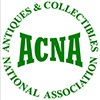 Sites Like AptDeco Are Changing The Selling Landscape Sites Like AptDeco Are Changing The Selling Landscape New York - Over the last ten years the options for antique dealers and vintage enthusiasts on where best to sell their wares online has become an increasingly refined process that has resulted in not only more precise and exact decorative arts listings, but has also created a wealth of new topic-specific industry websites specifically geared to such sales. Gone are the days when dealers were stuck with a broad spectrum two-choice listing on either eBay or Craigslist, or the sometimes unreliable and confusing categories of Facebook's Marketplace. Today, antique and vintage dealers can choose from a myriad of site-specific options when it comes to marketing their inventory online. To find out what sites worked best, staff writers at the school spoke to a number of industry insiders to get their take on how some online sales platforms have created or developed new approaches related to the marketing of decorative arts items, in order to offer dealers more choice and options when it comes to promoting their goods. Below, we've tabled some of those results. Offerup is one of Janet Cowers favorite selling sites. Cowers, who operates her own antique and vintage business in Portland, Oregon, says one of the sites best features is the integrated ability for buyers and sellers to negotiate out a price (hence the name). She's also fond of the regional approach whereby sellers and buyers can meetup to avoid any shipping fees. While some service fees can apply, they're not huge she says. As with many of today's best sites, you’ll need to download the app, provide some good quality photos, a well-written description, and a listing of your general geographic location. Cowers says she takes inventory that hasn't moved in a month and places it on Offerup at a discount. "So far the results have been outstanding," says Cowers, "I've really been able to save on the shipping of big items by loading-up multiple orders and delivering them in a single day to different local customers at one prearranged location." According to Cowers, she uses a large parking lot at a nearby conservancy hiking trial as a drop-spot, since it's highly visible, free, and offers lots of room for unpacking and packing-up for her clients. Going one step further on the regional purchasing and selling scale is Bookoo - a site that claims its legacy comes as a result of yard sale fans who decided to create a site for other yard sale fans (minus the actual going to yard sales part). Wendy Dalton who runs two vintage Etsy shops from New Jersey, says she's a believer. "I buy almost as much stock as I sell," she notes. "However, the great thing about Bookoo is how local it is - sometimes I'm literally only a block away from picking-up or selling some of my inventory." Dalton says she's used Offerup as well, but thinks prices are better on Bookoo. "They want everyone to know their site is garage sale sourced," she says, "which means you have to buy right in order to sell here and still make a profit." The registration process is straightforward though, and according to Dalton, once you're account has been setup, Bookoo lets you list an unlimited number of items. "I really like it because it has more of a community feel than some of the other sites," says Dalton, "It's almost like a chat-group!" Thomas Dryer is also a fan of regional buying and selling. Hailing from San Francisco with both an online presence and bricks & mortar shop, Dryer says he previously used eBay for his online sales but became tired of the escalating prices. Today, he says he's switched to eBid for listing and selling some of his finer vintage stereos from the 1970s and 80s using a local pick-up option. Aside from their very low commission rate of 3%, Dryer feels that eBid is a great alternative for those wanting to avoid rising fees associated with conducting business on eBay. "They have literally all the same features as eBay," says Dryer, "including the ability to import any of my items on eBay, directly over to my eBid account, which means I can get a lot more exposure for some of my items." Dryer says that his sales have been just as good on eBid, and that he's currently considering a lifetime membership for $50 that would drop his already low fees even more. "It's a win-win," says Dryer, "I'm saving money and selling more."  Sites Like Offerup Encourage Members To Meet Locally Sites Like Offerup Encourage Members To Meet Locally Remoov has become a recent favorite for many antique and vintage dealers because of its full-service offerings. Maria Alcaraz, who operates a number of consignment and vintage shops around the Tempe area in Arizona, says that it's all about the ease of use. "When something hasn't moved, and I need it gone to create more space for fresh inventory," she says, "I can literally take a few pictures, and set-up an appointment for the folks at Remoov to come and get my stuff." Alcaraz acknowledges that sharing the 50/50 split with the company after the item sells means there's not much room for error on her part, but notes that they're paying for the pickup, listing, and resale of the items. "I think that's pretty fair," she says, "and it allows me to dispose of slow moving inventory while still getting paid." If you're in the Northeast, like Natalie Barber is, then you're in luck. Barber, who owns a higher-end mid-century modern and vintage business in the San Francisco Bay area, says she uses AptDeco almost exclusively as her online go-to when it comes to selling large furniture pieces. According to Barber, listing only takes a couple minutes and AptDeco handles all the moving and pick-up. "I'm tiny, so loading and unloading big pieces of furniture can be an issue for me, that's why I like AptDeco so much," she says. Aside from the convenience factor, Barber also likes the fact that rates are reasonable (23% on sales), but more importantly, she says she likes that the average time from pick-up to pay-out is around ten to fifteen days. "It means the money I spent on past inventory isn't just languishing around for months in a company's warehouse." Finally, for those in the business who deal almost exclusively in the top-end range of the decorative arts field, there's Sotheby's Home (Buy Now) option, which according to New York dealer Carl Franks, is one of the better online venues when it comes to selling Georgian furniture. "I've tried them all," says Franks, "including 1stdibs, Charish, Ruby Lane, and more, but for me, Sotheby's has been by far the best." Franks admits that the listing prices ($1000 minimum), and commissions can be quite high (around 50%), but says for that kind of money you get a team of experts to review your submissions and who'll be there to proactively sell your items to a selective audience. For many dealers over the last few years, the growing number of options available for online inventory sales has simply come down to a greater combination of choice and selectivity rather than just gross site viewership. No longer stuck with single all-encompassing listings on behemoth websites that have little relativity to local sales, dealers it would seem have now finally found their niche in decorative arts websites that seem more geared towards them, rather than everybody else. For those looking to enter into the current decorative arts field, this is certainly good news, as it should provide nascent dealers with additional streams of revenue sources aside from today's standard online and main street formats. - A.I.A. Staff Writers 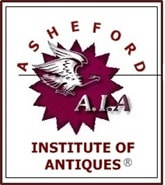 NOTE: For readers seeking more information about the Asheford Institute Of Antiques distance-learning program on professional-level appraising, the study of antiques, collectibles, vintage and mid-century modern items, please click here to visit the school's Home Page. Should you have additional questions about the Asheford program, you can also write to the school at: info@asheford.com or call the Registrar's Office toll-free at: 1-877-444-4508. 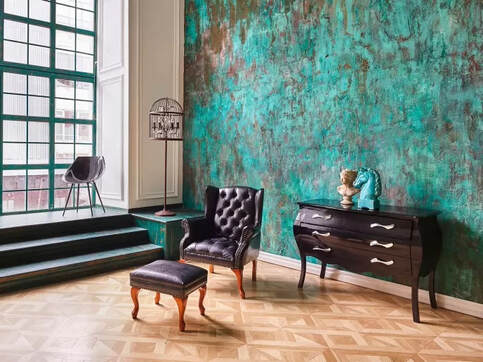 Antique & Vintage Sales "Tops" In Decorative Arts Markets Antique & Vintage Sales "Tops" In Decorative Arts Markets New York - Oh, what a difference a few years can make, especially when it comes to the world of the decorative arts. From proclamations of "It's over," to "people just don't want that old stuff anymore," the claims relating to the demise of the antique and vintage industry over the last twenty years have been about as plentiful and exaggerated as those levelled against the famed American satirist, Mark Twain. In fact, not only has the antique and vintage industry been thriving recently, but since the onset of the pandemic, the public's demand for decorative arts items from the past has literally exploded across every major sales platform to be had - from bricks and mortar shops, to pop-ups, and every conceivable type of online concern in between - the antique and vintage industry is now experiencing a wave of popularity and profitability that up until now, has never been seen before. Bolstering this claim, the most recent Global Home Furnishings report, produced by ResearchandMarkets.com, which tallies worldwide sales for this sector, indicated that while everyone had clearly spent more time at home during the last few years due to the pandemic, they also spent more money to furnish their homes, with worldwide decorative arts spending growing over twenty-eight billion dollars year-over-year. While e-commerce sites specifically related to decorative furnishings saw growth across the board, one market category from the report in particular stood out for the massive increase in sales volumes above all others; the antique, vintage, and consignment industry. As would be expected with reports of this ilk, theories abound as to why this particular area of the decorative arts segment is seeing such a strong resurgence in popular interest lately. However, for many industry insiders, the answer to that question may be more about a convergence of multiple market conditions and coincidental timing, rather than a single determining factor or theory. For Janet Cain, who runs three separate Instagram stores, it's all about the pandemic. "It really started there," she says, "from the moment Covid hit, sales literally blew-up and haven't stopped since." Cain believes that people got used to seeing and tracking items online from the comfort of their home, which made purchasing super easy, and by extension, created more opportunities for buying. "I have more repeat customers than ever," says Cain, "and their buying a lot more than before." Cain thinks that in some ways the pandemic created a new world-order when it came to making purchases online. "Before it was a choice, but during Covid it often became your only option," she says. "Now I think people have just gotten used to it and enjoy the convenience of not having to trek across the countryside in search of that perfect find." Others in the industry see a larger overall picture when it comes to understanding the recent surge in popularity for everything antique and vintage. Anna Brockway, the co-founder and president of Chairish, an international online antique and vintage furniture site, whose revenue has more than doubled in the past year, thinks that there is no question that vintage is hot right now. Brockway says, "Not only is vintage furniture beloved for its chic, one-of-a-kind style, it’s also increasingly appreciated for its immediate availability and sustainability. Right now, due to serious supply chain snarls, contemporary furniture manufacturing and delivery is moving at a glacial pace, while shoppers' expectations around speed and instant availability have never been higher." Posters who've listed items for sale on Chairish, say it's a clear example of buyers (especially younger ones), increasingly wanting sustainable and unique items with a little history to them instead of the sameness that often comes from big-box stores. Another piece of the puzzle, at least according to Christina Williams, who runs a number of high-end consignment shops in and around Atlanta and Savannah, thinks the explosive growth of interest in antique and vintage furnishings is also likely a direct result of price. Why? Because, for the most part, consignment pricing for quality items is almost always going to be cheaper than purchasing comparably newer items, which makes the consignment option an attractive proposition for savvy buyers, especially during uncertain economic times. Williams says her numbers over the last twelve months have been so strong that she now has a 'buy team' that scours high-end Atlanta neighborhoods with homes for sale in an attempt to beat out Estate Sale companies for the rights to sell the clients goods and chattels. "Demand is so strong," says Williams, "that if I didn't get to some of these houses first, and come out with a signed contract, I probably wouldn't have enough inventory at months end to stock my stores." Statista, an international company that specializes in market and consumer data for businesses, says that conservatively they expect the antique, vintage, and consignment furniture resale market to increase by over seventy-percent in the next few years. So what's fueling this current market growth? Well, for starters, many analysts point to the changing buying tastes of young Millennials and Gen Z consumers who started the "used" trend with vintage clothing, while seamlessly transitioning that into used furniture. Originally part of the Ikea mindset, many began to finally balk at the uniformity of design, and instead sought out uniqueness in not only their clothes but home furnishings as well. Now, with some discretionary income finally arriving, Millennials and Gen Z'ers are pursuing even more one-of-a-kind purchases that are in keeping with their collecting preferences, and which often come with a more expensive price tag. In fact, in a recent survey conducted by Chairish, over thirty-one percent of Millennial and Gen Z respondents said that they had become much more interested in buying used, vintage, and antique furniture online over the last two years, than in the two years prior. Jason Stavros, a young engineer from San Diego, perhaps embodies this new generation of decorative arts enthusiasts best, as he seemingly identifies with many of the factors that appear to be connected to the popular themes currently attributed to the rise of interest in the antique and vintage marketplace. "I'm an engineer by trade," says Stavros, "but I started buying and selling second-hand stuff just before the pandemic struck as way to save after I graduated university." Today, Stavros says that his interest in the decorative arts is more about being unique, buying something with a sense of history, helping the environment by upcycling, and avoiding supply-chain issues where possible. "I list on Chairish and quite a few other sites in my spare time," says Stavros, "but business has been so good recently that I'm giving serious consideration to hanging my own shingle and hitting it full-time... Or, as I like to call it, time to bring in the old!" - A.I.A. Staff Writers  NOTE: For readers seeking more information about the Asheford Institute Of Antiques distance-learning program on professional-level appraising, the study of antiques, collectibles, vintage and mid-century modern items, please click here to visit the school's Home Page. Should you have additional questions about the Asheford program, you can also write to the school at: info@asheford.com or call the Registrar's Office toll-free at: 1-877-444-4508.  Dealers Get Creative Dealers Get Creative New York - Deborah Torres had always dreamed of operating her own antiques and vintage business. As an avid garage sale attendee while in her teens, Torres would scour the east coast of Florida from Jacksonville to St. Augustine in search of anything that caught her eye and collecting interest. "I didn't really have a ton of money to start out with" says Torres, "but I had an old mini-van that was gifted to me by my father, so I had some cheap transportation and room for a good sized haul." By the time Torres hit her mid-twenties, she'd run out of storage space for her collectibles at the family house, and her father was pushing her to either move, or move her "stuff" out. With her van and a trailer loaded up, Torres decided to take the plunge and rented a small booth at an antique mall down the road from her home. Fast-forward twenty years later, and Deborah Torres is still in business, and says she looks back fondly on those early years when she was just starting out, but wishes she'd known a little more about the antiques and vintage trade before fully committing to it as a lifelong career. "I love it, but having some training or guidance would've really helped me grow my business at the beginning," she says. 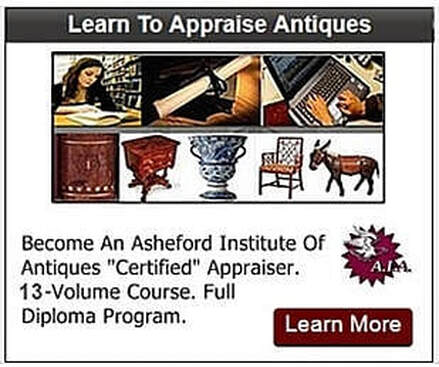 Torres isn't alone in that sentiment, with many dealers claiming that it's an old refrain; "How best to jump start one's antique and vintage business while making as few costly mistakes as possible." Jenn Gould who successfully operates a number of online concerns from Etsy and eBay to Artfire and Bonanza, says that there are some simple rules for helping people run successful decorative arts businesses. Number one she says is understanding your inventory. "Don't buy what you don't know (or love). I've seen so many people try to be an expert on everything, and end up making bad buying decisions on stock that eventually costs them in the long run." Gould believes that if you stick to what you know and like, you'll end up learning about it organically because you'll truly want to know it's history and value together. "It may sound simple," says Gould, "but you'd be surprised how many people get off-track and end up over-paying for items they'll never be able to sell for a profit." Also on Gould's list for successful strategies is proper bookkeeping, which she says is paramount, and often overlooked, when it comes to tracking whether or not your business is actually growing. Lastly, knowing your customer base, especially if you're keeping a database of those who purchase from you online, as this can be one of the best tools for ensuring that you're matching your inventory to those who are interested in buying it. According to Gould, "Building up a profile for each customer, and trying to tailor your resale purchases towards that end is crucial." Gould attributes this process to return customers becoming the bread and butter of her business. For those running strictly online concerns, there are a number of considerations one must take into account when attempting to strategize a plan of action for antique and vintage sales that may not necessarily equate with a bricks & mortar store. Charles Caulfield, who operates a wide range of collectible businesses on numerous digital platforms says that reveals and drops (the unveiling of products), can be particularly important to overall sales based on how they're presented. "When I'm selling Christmas collectibles," says Caulfield, "I'll drop my entire collection at once to try and generate some buzz, rather than just trickling them out one by one." However, sometimes it's not seasonal says Caulfield, but simply based on a theme of collectible items that he might have in stock. Key to employing this successful strategy, is using Facebook and other online platforms to poll his followers and customers about what they're interested in. "I try to stick to a schedule as well," says Caulfield, "once my contacts have indicated their interest in a particular genre or item, I try to drop those sales on a regular basis." Caulfield says that since he's started doing consistent reveals based on polling his sales have risen dramatically. Like Gould, Caulfield also attributes a large degree of his success to keeping detailed records along with a strong customer database.  Digital Strategies Apply To Bricks & Mortar Businesses As Well Digital Strategies Apply To Bricks & Mortar Businesses As Well For Deborah Torres the digital lesson came late. "After setting up my first booth in Florida, I concentrated on nearby locations and worked on adding additional spaces at new in-person venues, but my sales eventually began to flatten." Torres says her daughter finally convinced her of the benefit of having an online presence and since then she's gone all in. "It's not that I wasn't online," says Torres, "It's just I wasn't doing much with it until my daughter showed me how." Now she says that part of her work week is devoted solely to doing things like expanding her customer list by following and interacting with other sellers, doing live feeds and shows, and even hitting up Tik Tok. One area that Torres claims she's seen strong gains in are boosted posts of Facebook and carousel style ads on smaller venues like Pinterest. "It takes some time to figure out the process for placing the ads, and you have to be consistent and understand the feedback, but in the end my numbers jumped by over fifty percent," she says. Interior designers and vintage gallery owners David Smith and his partner Neal Brown, are also of the mind that a good customer database can be an excellent place to start when trying to supercharge your business, but thinks that dealers should also take note of the broader scale of what's trending in the current decorative arts marketplace if they want to increase sales. Smith says that while you don't need to jump on every trend that pops up, keeping tabs on those that have some longevity can really help your business grow in the long run. "I've watched American Pickers for years," says Smith, "but what's really interesting for me is not so much the finding part, but what they end up bringing back to the store." Smith says that in all the years watching the show he's noted that they tend to pick a few genres in particular, from petrolina to toys, that always remain in relative favor with buyers and collectors alike. Smith believes that having a sense of where the market is in terms of popular trends can help both in minimizing costs for buying future inventory as trends ramp up, and also when it comes time to pricing an item before hitting the showroom floor. One thing Smith notes that he says might sound obvious, but is not, is offering customers and clients something for free. Smith says he works on a short monthly newsletter about trends, vintage items, interiors, etc. which is provided solely to his businesses social media followers and customer base. "It creates a feeling of exclusivity among our clients," says Smith, "and it also tends to keep them coming back as customers." There is of course no iron-clad panacea for being able to drive sales and clients to one's business, however, for a number of antique and vintage dealers these are some potential strategies that have done just that. For Deborah Torres, building new relationships by reaching out to her community, both online and in-person have payed off handsomely. For Jenn Gould, tailoring the buying experience to established customers has provided her business with plentiful dividends. However, quite possibly the most nuanced strategy for achieving an exceptionally profitable decorative arts business may have been summed up best by interior designer Neal Brown, who claimed that the biggest reason for his rising success in the industry was due to a real-world alignment between how much effort he thought he was putting into his business, versus what he was actually achieving on a day-to-day basis. "Taking honest stock of one's efforts on a daily basis is simply a great motivator," he says, "it helps keep your business strategies moving forward... and upward." - A.I.A. Staff Writers  NOTE: For readers seeking more information about the Asheford Institute Of Antiques distance-learning program on professional-level appraising, the study of antiques, collectibles, vintage and mid-century modern items, please click here to visit the school's Home Page. Should you have additional questions about the Asheford program, you can also write to the school at: info@asheford.com or call the Registrar's Office toll-free at: 1-877-444-4508. 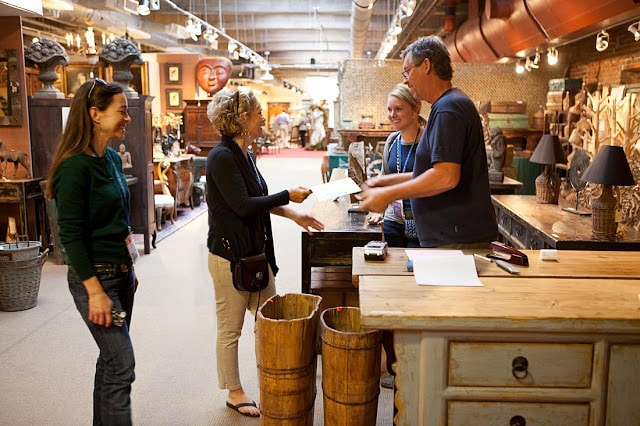 Dealers Report Brisk Sales As Customers Pivot Dealers Report Brisk Sales As Customers Pivot New York - For Amy Hacker, starting her own antiques and vintage business prior to the great pandemic, seemed like a no-brainer, at least that's how Hacker describes her decision to leap first, and think later. Hacker, who grew up on Long Island in an artsy family - with a dad who played in an orchestra, and a mother who worked at the Met - had always been surrounded by people who appreciated things that were old, rare, and intrinsically beautiful. "My mother would come home with tales from the museum, and on the weekend, we'd try to recreate the experience with trips to antique stores and estate sales," she says. Hacker believes that by the time she was in her early twenties the dye had already been cast and starting her new decorative arts business became a matter of when, not if. "I think I simply lucked out," she says matter-of-factly. "I opened during the pandemic and my sales literally took off on day one." Hacker said she fully expected things to calm down once people returned to work and Covid hit the rearview mirror, but they didn't. "As soon as the first supply-chain issues started cropping up, I began to notice an almost immediate bump in furniture sales," says Hacker, "and since then, it's just been a steady stream of inventory flying out the door - I simply can't keep up." Hacker isn't alone in her dilemma. Antique store owners, thrifters, and vintage dealers are all reporting incredibly strong sales, especially in items related to furniture. But it's not just the smaller players who are seeing the love from consumers, but the bigger venues as well. Vintage and secondhand furniture retailer Chairish has seen a 70 percent increase in sales recently, while everyone's favorite high-end collectible site 1stDibs, whose biggest online category segment is furniture, popped with a 25 percent increase in numbers related to case goods and chairs. Over at Kaiyo, another relatively new-to-the-scene used furniture and vintage startup, the numbers were even more impressive, with representatives claiming blistering triple-digit growth month-over-month. Tom Claremore, who's been selling moderately priced furniture on 1stDibs for years, says that he's never experienced anything like it. "My stock is literally down to what I can find on weekends - getting it uploaded by Monday night - and it's gone by Friday." Claremore says he can draw a direct correlation to the news about furniture imports just sitting on docks or ships out in the ocean, and the spike in his business. "It's certainly not rocket science," says Claremore, who admits that seeing chain-furniture shops with vacant display windows was about the same time he began to notice a substantial uptick in sales. "Once I saw those empty stores, and pictures of piled-high containers with nowhere to go, I started putting the pieces together," he says. Claremore, doesn't believe the current situation will last forever, but is fairly confident that as long as supply chain hold-ups remain, in concert with inflationary pricing, he thinks the value in antique and vintage furniture is going to be an attractive option to a lot of consumers for quite some time. 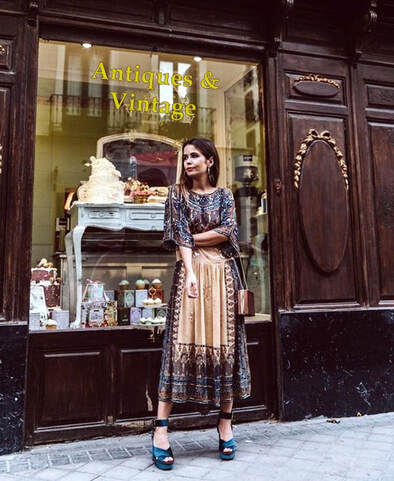 Younger Generation Continues To Reshape Marketplace Younger Generation Continues To Reshape Marketplace Aside from anecdotal evidence from those in the trade, recent articles in the New York Times and Washington Post are also backing up these claims, reporting similar stories, with supply chain issues being just one of a number of important factors that many in the decorative arts world are describing as the perfect storm of events leading to the resurgence of the antiques industry. Tracy Holland, a late twenty-something from New Jersey, who's hoping to get into the antiques and appraising business after she completes her college degree, says that her interest in buying used items springs from her generation's belief in upcycling and repurposing things to make them sustainably viable. "I used to see some of my friends walk out of Ikea with a complete living-room ensemble, only to landfill it, once they'd moved into new digs," she says, "but today, it's almost unheard of." Holland recognizes that price-points and the lack of availability due to supply constraints may have something to do with the shifting buying patterns of her generation, but believes it goes much deeper than that. "I think people are just far more conscious about the environment now, and if that happens to coincide with great prices on lasting furniture and antiques from the past, so much the better." Dayna Johnson, a trend expert from Etsy, takes it a step further and believes it's literally a win-win situation for everyone. “As people increasingly shop with their values, buying vintage furniture enables sustainability-minded shoppers to reduce their carbon footprint, all while supporting small, independent businesses,” she says. For others, it doesn't even necessarily have to translate into an interest in antique or vintage items at all. With so much money being spent on remodeling during the pandemic, there's a massive amount of pent-up frustration on the part of consumers who have been waiting months on end to finally furnish some of these empty spaces. With no end in sight to the supply chain shortages, many of these crestfallen consumers have turned to the antique and vintage industry as a means to fill the gap. Nathaniel Dixon who's been operating a number of high-end antique and vintage booths along the east coast for the past twenty years, says that it's an entirely different breed of customers frequenting the shows now. "In the past, we used to have clients who really knew what they were buying, but today, most of what I see is just folks looking to fill the spaces in between," he says. "I'm not complaining, but it's just interesting to see pieces being scooped up without an eye to style, fitment or even cost." Dixon believes that one positive takeaway however, is the fact that he's getting good quality furniture out in front of consumers who might not have otherwise ever considered antiques as an option. "I think when they see the difference, there's a good chance we'll have some converts," he says, "even after the supply chain issues are resolved." How long this will last is of course anybody's guess, but almost all those working within the industry agree that the current antiques and vintage markets are as strong as any they've seen in recent memory. Will the end of supply chain issues negatively impact this rising decorative arts tide, or have interest levels already risen to such a high degree that a quick retreat is unlikely? For most experts, the answer may lie in the numbers prior to the pandemic, when decorative arts sales were already surging well before there were any signs of a worldwide blight, or a lack of speedy ships to get goods to market. However, as with most blanket predictions... only time will tell. - A.I.A. Staff Writers  NOTE: For readers seeking more information about the Asheford Institute Of Antiques distance-learning program on professional-level appraising, the study of antiques, collectibles, vintage and mid-century modern items, please click here to visit the school's Home Page. Should you have additional questions about the Asheford program, you can also write to the school at: [email protected] or call the Registrar's Office toll-free at: 1-877-444-4508. 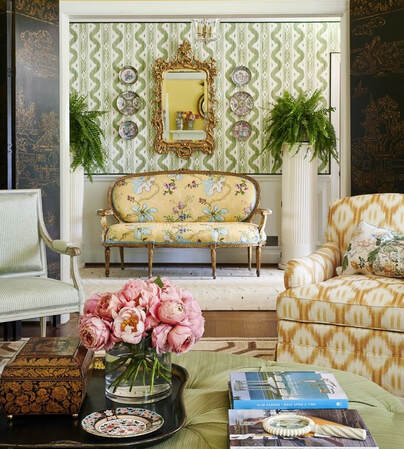 Patterns & Prints Return Patterns & Prints Return New York - For many antique and vintage dealers it can be easy to lose sight of the proverbial what's-popular "ball" sometimes, especially when it's tossed across the field so frequently with little advance notice. While online behemoths like Etsy, eBay, and Wayfair are often considered the barometer for what's trending and popular in the marketplace at any given time, there are many industry insiders who actually take a contrarian view, believing that the Internet giants are more of a market laggard than they are a predictor when it comes to deciphering the current direction of decorative arts trends. 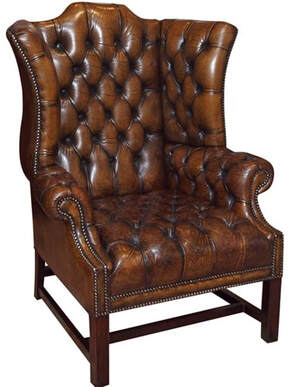 Wingbacks Gain Favor Wingbacks Gain Favor For Tamara Holt, an interior designer and fine-arts dealer from Paris, who works both sides of the Atlantic, figuring out up-and-coming trends is more about who you're listening to, than what. Holt credits much of her business success as a dealer for having an open ear to younger collectors, who may not have the money for lavish purchases, but are often on-point when it comes to burgeoning marketplace moves. "Last year while attending local antique markets, I noticed that 20-somethings were beginning to take an interest in period pieces, like wingback chairs, rolled-arm sofas, and French country-style dining tables that had a little history attached to them. I even saw some velvet pieces moving," said Holt. According to her bio and business blog, much of what she puts in her storefront tends to be transitionary. "If I see changes happening within the collectible landscape, I'll also try to incorporate and reflect that change into my interior design motifs for the upcoming year," she said. Holt noted that many of her clients in New York also appeared to be retreating from the overly modernized design base that's been so prevalent for so long in the decorative arts community, and have instead begun moving back to more established styles of decorating. "I'm getting lots of requests for natural wood antiques, stone-topped pieces, and even pattern textiles and linens," says Holt, "All of which is a huge departure from what I've been seeing over the last eighteen-months." 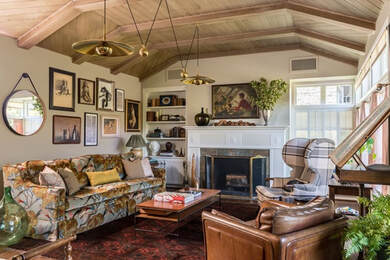 Softer Hues & Natural Wood Softer Hues & Natural Wood Of course, picking-up on the latest decorative arts trends can come from a variety of sources - including those whose job consists of recognizing such trends as they're just beginning to happen. Design Diva, Roxy Owens of Society Social, says that it's time to say goodbye to monochromatic neutrals and minimalist design features and welcome back more traditional themes of decorating. “Now more than ever we are seeing a return to cozy and warm interiors. Think beautifully layered spaces, a mix of prints, patterns, and colors, delicious wallpapers, textures, pleated and patterned lampshades as well as bespoke textiles.” While some are calling this trend the Minimalist-revolt, and the first true break from the Mid-century modern movement, others are simply referring to it as the rise of Maximalism. Whatever you choose to name it, the general consensus from many design professionals is that the return of warm wood tones in the form of antique furniture, and those elements associated with it, appear to have finally arrived back on the decorative arts scene after a rather lengthy sabbatical. Printed sofas, wall papers, leather chairs and even plaid and floral prints on upholstered antique and vintage chairs are all making a dramatic comeback. 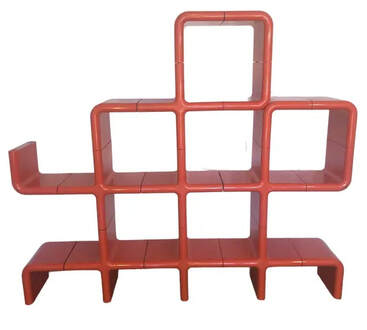 70's Modular & Recycling Are In 70's Modular & Recycling Are In While some industry experts agree with the notion that 2022 may possibly be the first year of a noticeable retreat in minimalism and Mid-century modern influences, there's full agreement amongst most designers that vintage furniture and 'going-green' will continue to be one of the most popular decorative arts trends for the foreseeable future. Tracy Shea, who operates a number of vintage themed booths along the west coast, and a storefront operation in San Francisco, says that young people are making 'environmentally' based decorating choices, and that it's changing the way she does business. "They want something sustainable," says Shea, "things that will last a lifetime and not contribute to the landfills." It doesn't have to just be antique furniture though she says, "As long as it's good quality and something that will last, it's selling." Shea also notes that supply-chain issues for more traditional furniture stores might be having a net-positive effect on her business, "If you can't get a cheap chest-of-drawers because it's sitting on a boat somewhere, I'm probably going to benefit from that," she says. Solid wood tables, bookcases, glass-topped pieces from the 1960s, and heavy molded and modular pieces from the 1970s are all in high demand. "It's really all about timing," she says, "Vintage and the Boho look (Bohemian inspired design) are all in, and I just happen to have access to that type of inventory." Tom Wheeler who specializes in outdoor wrought iron and vintage furniture, along a coastal tourist route just east of Toronto on Lake Ontario, says that he noticed a small drop in interest last year related to modern-metal themed pieces, and an uptick in requests for rattan, wicker, and old wrought iron items towards the end of the summer. "I don't know if it's a move away from mid-century themes," says Wheeler, "but there's definitely been more requests for traditional types of garden and outdoor furniture like I used to sell." Wheeler who's been in business for almost half-a-century says that based on his experience over the last fifty years, he thinks we're probably due for a change. "I've sold more 50's style metal tulip chairs than I care to remember," says Wheeler, "I think I'll just be happy to see something different come along." Predicting and caressing the crystal ball always comes with risks, but for many dealers and collectors the writing on the wall has apparently become far more clear recently as a sizable consensus appears to be building for a move away from the modern design sensibility, and a return towards the softer lines of more organic shapes and earth-toned hues. Whether or not this growing interest in all things antique and vintage can truly and fully supplant the current retro-modern decorative arts theme remains to be seen, but with so many marketplace-experts and industry-insiders currently on board, now might not be the best time to bet against the house. - A.I.A. Staff Writers  NOTE: For readers seeking more information about the Asheford Institute Of Antiques distance-learning program on professional-level appraising, the study of antiques, collectibles, vintage and mid-century modern items, please click here to visit the school's Home Page. Should you have additional questions about the Asheford program, you can also write to the school at: [email protected] or call the Registrar's Office toll-free at: 1-877-444-4508.  New York - Now in its thirteenth year, the Asheford Institute's annual survey of top decorative arts buying trends from the past twelve months has just made its way onto both digital and paper newsstands across the country. The survey and poll of past students and graduates has become a staple to many in the antique industry for its unique ability to look into the current state of today's decorative arts marketplace as it relates to overall sales trends for dealers within the collecting community as whole. Lead researcher for the school, Anthony Harper, says the key to getting print-worthy survey results that people can actually use to help plan their own buying strategies for the upcoming year is based on receiving actual sales data, alongside item-specific requests from buyers, which can then be used to indicate interest within a particular collecting genre. As with virtually everything this past year, Harper says the ongoing pandemic continued to have an effect on not only large scale supply-chain issues for new and freshly minted items, but also for older collectibles with a few more miles on them. "Last year categories like costume and period jewelry boomed," he said, "but this year, it was all about finding inventory." Harper believes that some categories in the poll rose or fell not necessarily because of a lack of popularity, but because of a lack of stable inventory. "When everyone is online doing stay-at-home on their computers it's going to have a net effect on available stock out there for dealers." However, not all things moved to the rhythm of the pandemic, at least according to Amber Shole, who's been compiling statistics for the survey for over ten years now. "Mid-century modern remained strong," said Shole, despite past survey indications that it may have peaked. "I think sometimes really strong trends can have mini-dips and valleys along the way and this is simply an example of that." Shole said that other perennial poll favorites like Art Deco and toys also continued fare well this year. For other areas of the survey there were some legitimate surprises, as once again an unexpected category literally rocketed to the top of the charts with seemingly little notice. What causes these apparent sudden swings in interest? Well, according to Shole, it's more than just about the age of the item, but also the age of the buyer that will often set the trend in motion. "Three years ago, there was a buying frenzy of baby boomers looking to collect anything related to the Apollo Moon missions 50th anniversary," said Shole. "But a year later interest peaked, and sales were relatively flat." End of story, right? Not according to Shole, who says that last year's roll out of a Chinese space station, SpaceX rocket launches, and the deployment of a ground-breaking celestial telescope, has reinvigorated the space genre with an entirely new group of younger collectors. "It just goes to show that sometimes a popular collecting category can literally come from nowhere and take the collecting world by storm," says Shole, "it's kind of exciting to see." For readers seeking the complete 2021 listing of all the best-selling antique and vintage genres and categories contained within the school's yearly poll and survey, you can find the full results (including this year's winner), by simply clicking on the link below... Link To Survey/Poll: **TOP SELLING ANTIQUE & VINTAGE CATEGORIES FOR 2021**  Emily Watkins is a freelance decorative arts writer, and an honors graduate of the Institute. She splits her time between New York and London as a contributing columnist to all things MCM and is also a recognized specialist in the field of Asian & European ceramics.  NOTE: For readers seeking more information about the Asheford Institute Of Antiques distance-learning program on professional-level appraising, the study of antiques, collectibles, vintage and mid-century modern items, please click here to visit the school's Home Page. Should you have additional questions about the Asheford program, you can also write to the school at: [email protected] or call the Registrar's Office toll-free at: 1-877-444-4508. 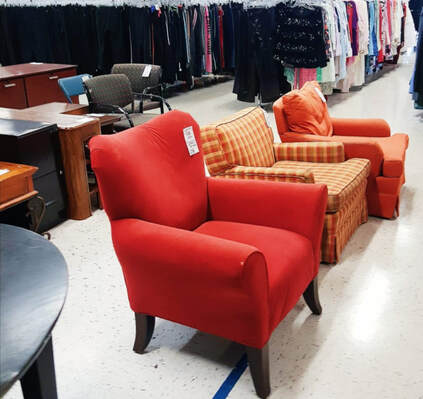 Savvy Dealers Sort Gems From The Junk Savvy Dealers Sort Gems From The Junk New York - For those in the antique and vintage business, hitting thrift stores to stock up on inventory can often feel like a bit of a treasure hunt. The lure of the hidden find is always there in the back of one's mind, but in reality, how practical is it to expect a walk-in win at many of these second-hand venues, especially considering the public's current interest and craze for scouring out anything old, vintage, and retro themselves? Well, according to some dealers in-the-know, the chances of scoring are still pretty good - providing you're aware of what's selling in today's decorative arts marketplace. 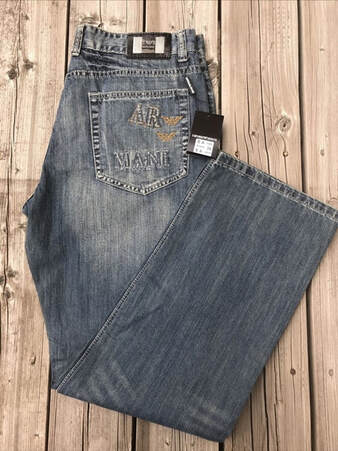 Branded Textiles Popular Branded Textiles Popular Christa Blanchard, a longtime textile seller in upstate New York, says location can mean everything when it comes to the art of buying at thrift stores (aka, thrifting). "For me, the wealthy neighborhoods definitely have a lot more inventory to offer, but it usually comes with a higher price," says Blanchard. “Stores in these areas tend to have employees who know what's valuable and what's not." Blanchard feels that while she may pay more for certain items such as name brands like Armani denim, or middling couture items from Michael Kors, the final return on investment is usually always going to be better. "I'm buying from rich neighborhoods, but selling in middleclass ones," says Blanchard, "It's a good way to turnover inventory from one geographic location to another, while making some money in the process." Although there's now more competition from everyday buyers, Blanchard believes that many of the best deals can still go unclaimed. "I once forgot a vintage Chanel scarf that I'd seen in a bin at one of my favorite thrifts," says Blanchard, "but when I came back two weeks later, it was still there." While noting that not all of her outings are outright wins, Blanchard attributes the majority of her thrifting success to simply being prepared. "It really helps to know what you're looking for if you want to profit from it," she says. 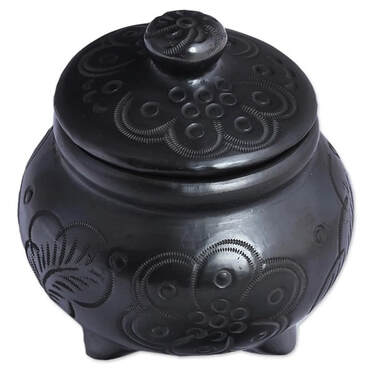 Mexican Ceramics Mexican Ceramics However, not all dealers believe you have to move upmarket to find the best deals. Donny Walsh, a purveyor of fine Pyrex products, and other collectibles, says that his inventory comes almost exclusively from thrifting in lower-rent neighborhoods in Los Angeles and outlying suburban areas. "I've always had good luck finding stock in rundown areas of big cities rather than the affluent parts of town," says Walsh, who chalks up the diversity of his finds to the multicultural aspect of the neighborhoods he visits. "Some of the thrifts I attend are in predominantly Latino communities, so many of the items being sold tend to reflect this heritage." Walsh says aside from his Pyrex collecting he's purchased a number of Barro Negro ceramic pieces over the years, as well as other pottery originally sourced from Mexico. "There aren't a tremendous amount of dealers scouring these neighborhoods, because most of these thrift stores are providing essential goods to people rather than merely decorative arts items for one to look at," says Walsh. But that doesn't mean deals can't be found. According to Walsh some of the best pieces he's picked up, including some Atzompa green-glazed ceramics, were literally in plain sight, while a patterned Pyrex bowl, which he later sold for just under a thousand dollars, was laying in a box next to the door with some pastry tins and mismatched cutlery. "I know my market," says Walsh, "so it's not a total surprise when some of these things just happen to pop up." 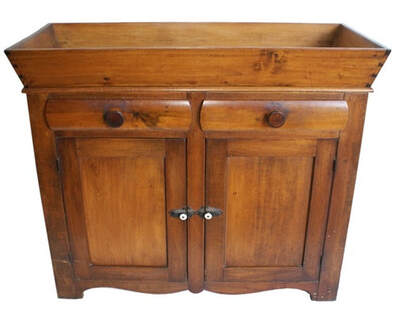 Thrifting Based On Local History Thrifting Based On Local History While most dealers agree that location can play a major factor in helping to determine what constitutes a top-notch thrift store find, for others it's often more about the history of the neighborhood, rather than its exact location on a map. For Jessica Reynolds, who's been dealing in early Americana and primitives since her father first introduced her to the antiques trade as a teenager, the Great Lakes region of Pennsylvania and New York have always been verdant picking grounds for thrift stores that were ripe with goods and chattels from local area farms. "I can remember a time when the entire contents of an old farmhouse that was being sold-off or liquidated would end up in the back-half of the town's local Salvation Army building," says Reynolds. "You could literally have your pick of untouched pieces in their original state - worn paint and all." Most of what Reynolds encounters today is still the same, but just on a different scale. "I recently came across an original pine dry sink - from the 1870s or 80s - that was lumped in with a few old bed-springs which had been hauled into our local thrift store from a residence just outside of town." While Reynolds acknowledges that the chances of finding high-demand pieces like this are now more rare, they do still exist she says. "We live in a region inundated with farms and early Americana furniture" says Reynolds, "in some ways, it's exactly what you'd expect to find." Other items that Reynolds says are still relatively common in her area thrift stores include, old blanket boxes, washstands and even the occasional 'authentic' harvest table. "Most of my thrifting comes from the stores in the smaller towns," says Reynolds, "because that's where I can usually find the best examples of old country furniture." 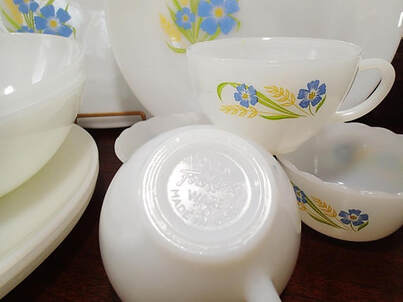 Fire King Dinnerware Set Fire King Dinnerware Set For Susan Haskin, and a number of other online dealers, it's often more about the type of store you're attempting to scout, and the relative timing of your purchases, that will determine whether or not your thrifting venture proves successful or not. Haskin, who's been running an Etsy business devoted to mid-century kitchenware and decorative objects from the same era, says that her favorite thrifts are often those managed by smaller religious ministries. "Goodwill and the Sally Anne are usually picked-over in my area of Seattle," says Haskin, "but the smaller one's, often formed by local churches, can be a great source for smalls, especially old kitchen items." Haskin acknowledges that living in an area with so many mid-century homes and apartment buildings is probably beneficial to her business, but also thinks that differentiating the types of thrift stores out there can help dealers make wiser choices. "I especially like to hit the little thrifters in spring, when everyone is doing their clean-outs," says Haskin. "I'll purposefully steer away from the big [corporate] players, because I know they'll either be busy, or over-priced." Haskin says she's witnessed a huge discrepancy in what thrifts charge over the last ten years as some of the more well known charitable organizations have raised their in-store prices considerably. "I understand their reasoning," says Haskin, "but I'm also running a business, so I have to go where I can get the best deal on buying stock." Haskin revealed that on average, she's still been able to get about 50% of her yearly inventory from thrift stores alone. "I'm still able to buy things like Anchor Hocking's, Fire King dishes for pennies on the dollar," she says, "but now it's mostly sourced from the smaller hole-in-the-wall thrifts rather than the corporate juggernauts." As with anything, there are of course going to be exceptions to any rule - including the value/time proposition one needs to consider when buying from thrifts. However, according to most dealers, the pitfalls of plying through old baby clothes and boxes of unwanted junk, are generally far outweighed by the potential opportunity to score a bountiful selection of reasonably priced inventory that can yield a handsome pay-off in the future. Providing of course you have some prior knowledge on the subject at hand - and can tell your Picasso from your Pollack. - A.I.A. Staff Writers  NOTE: For readers seeking more information about the Asheford Institute Of Antiques distance-learning program on professional-level appraising, the study of antiques, collectibles, vintage and mid-century modern items, please click here to visit the school's Home Page. Should you have additional questions about the Asheford program, you can also write to the school at: info@asheford.com or call the Registrar's Office toll-free at: 1-877-444-4508. These young dealers are shaking-up and dramatically changing the decorative arts community in new and unexpected ways 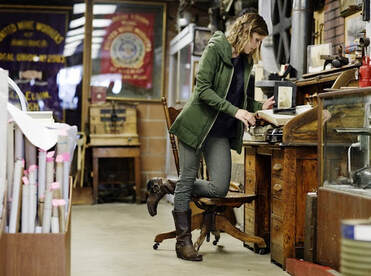 Next-Gen Dealers Expand Traditional Boundaries Next-Gen Dealers Expand Traditional Boundaries New York - For many in the business this day has always been a little bit like smoke on the water - something that often appears - but with no guarantee of arrival. However, in this particular instance there's no question that the recent prevailing winds of the decorative arts have quite literally blown in a generational change that's shaken up the antique and vintage industry's genetic make-up on a global scale. Even as Gen-X'ers gave way to Millennial's, and then to Gen-Z, it has always been apparent that Baby-boomers were the one's wielding the lion's share of power in the decorative arts world, while simultaneously controlling the markets forward direction, at least until now. Whether due to natural attrition, a renewed interest in our shared past, or perhaps a simple break from flat-pack and Ikea inspired furniture, it now appears that the industry's latest up-and-comers have finally wrestled the antique mantle away from not only the older boomer-generation, but also from a business model rooted in another century. With many of these new-age dealers reporting in well under the age of forty, and sporting such professional and diverse training resumes from the tech, media, restaurant and fashion fields, it's no surprise that their methods for achieving success would also be entirely different than that of their predecessors.  Vieira Likes To Keep It Simple Vieira Likes To Keep It Simple For Heather Vieira, the trip has always been about a connection to the past. When she was young, she would wake her father in the very early mornings to attend New Jersey flea markets to experience the sites and sounds of the carnival-like atmosphere. After managing a fast-paced restaurant for years, she finally packed it up and moved to New York where she began dealing in old picture frames, eventually setting up a full-fledged business flipping antiques to other dealers. Unlike traditional business models in this industry, Vieira changed the mark-up formula and focused solely on things that would turnover quickly; chairs, lamps, artwork and tables. "I'm only tacking on 20 or 25 percent so I can move it along and buy the next piece to sell.” Vieira says that by pricing with low mark-ups, she's been able to move her stock quickly to not only the general public, but dealers as well. Being net savvy and keeping a solid email list going out to her dealer contacts has also helped her business flourish. “Everything is relative to the thing you’re selling. I always want to give people a super good value because I want them coming back to me," says Vieira. While acknowledging that her business model is a bit unorthodox, Vieira's the first to admit that in order for this to work other people have to make money off the process as well.  Instagram Helped Launch Bentley's Career Instagram Helped Launch Bentley's Career On the other side of the pond, a fresh batch of diverse and under-forty dealers has also begun to take hold of the industry. However, what's remarkable about these young guns is that not only have they been able to bring along the antique traditionalists, but they've also been able to inspire a new generation of collectors and buyers to follow them through the use of detailed and age-pertinent item descriptions on social media. For British dealer Adam Calvert Bentley, his start came as a result of a single stint at an antiques show, and a helping-hand from a friend who encouraged the launch of an Instagram account for his wares. "My first post was a photo of me setting up," said Bentley. After some initial online success, he continued to develop and work the branding of his IG presence, which eventually led him to become a full-time dealer. Today, Bentley is recognized as one of the top up-and-comers in London when it comes to items from the 16th, 17th and 18th centuries. His inventory is eclectic, with items ranging from Louis XVI lanterns, to Chinese export pieces, and oversized eighteenth-century armchairs. 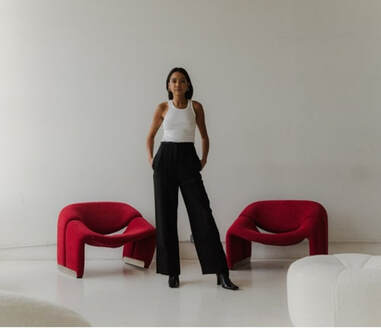 Necessity Creates Online Design House Necessity Creates Online Design House While many of these young dealers are leading the generational charge when it comes to the antique market, there are also those cutting a successful path into the world of upscale vintage items as well. Maggie Holladay, who started out in the fashion world, but who currently sells high-end vintage pieces and contemporary art on her Claude website is another example of a young gun inspired to do business differently. Her early interest and substantial collection of apartment-cluttering onyx coasters and ashtrays (which she purchased on eBay in 2018), eventually led to the downsizing of her collection when living space became an issue. However, in the process of liquidation, she also created an online venue for selling her wares. “I started out with little marketplace finds, but then found one amazing item and made a huge profit off it,” she says. “I repeated this process of saving up to buy one really great item and reselling it.” As of 2021 her Instagram account for her vintage design shop currently boasts over 145-thousand followers - an impressive figure for anyone - especially in a span of just three short years. 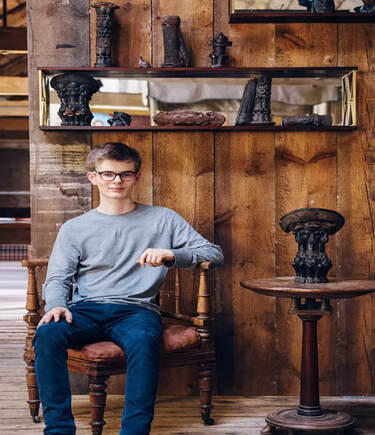 Hurst Comes By The Trade Honestly Hurst Comes By The Trade Honestly Of course there are also a few young and knowledgeable upstart collectors who are in fact almost preordained to become celebrity's within the decorative arts field - especially if their name happens to be Tom Hurst - and their father (Edward), is known as one of the greatest UK antique dealers of all time. However, even with pressures such as this, it was no surprise that the young Tom would take to the family business with a certain amount of gusto, honing his passion for collecting at an early age with digs for fossils and china, then moving onto medals and militaria, before deciding on tribal art as a young teenager. Over the years Hurst built up his core knowledge through museum visits, selling some of his artifacts while at boarding school (in order to buy more), and by attending major tribal art sales at auction houses. Today, Hurst's tribal art and 'country-house' objects can be found on his website and Instagram page, which has grown to almost three-thousand followers recently. In addition to sales, the young 19 year-old has also been hired as a top-tier consultant for a number of major auction houses in the UK as a specialist in the field of tribal arts. While much of the Next-gens use of growth tactics within the decorative arts industry may appear somewhat benign at first glance, the devil is in the details. From encouraging quick sales by reducing mark-ups to both the public and dealers alike, to focusing on limited but popular 'types' of inventory that results in high turnover ratios and a more fluid cashflow for businesses. For other young upstarts, it's been the very selective and targeted use of social media. Crafting followers from different veins of the Internet ether that aren't just click-and-forget friends, but individuals that are actively engaged in one's brand on an almost daily basis. For those who've patiently waited for the new millennium to break out with fresh-faced collectors and buyers, it's been a generational revolution that's been a long time coming. And, while some boomers in the industry may be sad to see the days of 'cash-registers' and 'sales-tickets' depart the standard business-coil, most of today's antique dealers would likely agree that it's more than a fair trade if we can finally entice an entirely new generation of collectors and buyers into the world of the decorative arts, for the price of doing business on the "Gram." - A.I.A. Staff Writers  NOTE: For readers seeking more information about the Asheford Institute Of Antiques distance-learning program on professional-level appraising, the study of antiques, collectibles, vintage and mid-century modern items, please click here to visit the school's Home Page. Should you have additional questions about the Asheford program, you can also write to the school at: info@asheford.com or call the Registrar's Office toll-free at: 1-877-444-4508. 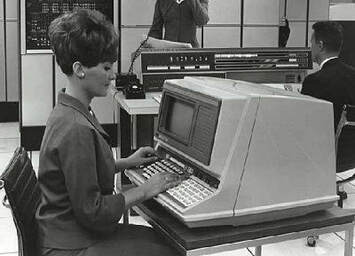 Early Electronics Rising Quickly Early Electronics Rising Quickly New York - In a recent article by Megan Slack, found in the prestigious Homes & Gardens Magazine, the claim is made that, "Interest in antique shops has recently risen by approximately 50 per cent, antique auctions have increased by 80 per cent, and antique markets have jumped by 129 per cent." While we're certainly not going to disagree with these figures, as our own in-house numbers have also shown a dramatic industry-wide bump in antique and vintage sales over the last year, the question many dealers and buyers seem most interested in, is exactly what type of antique and vintage items are spurring these impressive sales figures. To get a better grasp of what's been selling so far in 2021, we decided to speak to a number of experts, industry-insiders, and decorative arts dealers from around the globe in order to get a more complete understanding of what's been pushing the antique and vintage markets to such highs over the past nine months. Below, is the list complied by our experts with their take on this seasons hottest selling items so far. 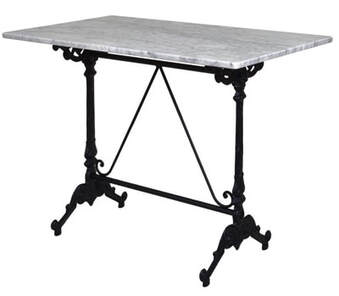 Outdoor Marble-Tops Remain Popular Outdoor Marble-Tops Remain Popular For Bridget Shaw, a veteran vintage dealer who retails from her barn in upstate New York, the infatuation with anything marble or stone continues. "Over the past couple of years we started to move to outdoor vintage and garden antiques," says Shaw "but this year has been absolutely crazy. I can't keep any travertine or marble topped wrought iron items in stock." Shaw says she really began to notice the uptick in outdoor garden and vintage furniture last year, but since then the demand has far exceeded her ability to keep pace. "We're literally selling 2-to-1 when it comes to outdoor furniture versus inside," she said, "I think I'll probably still be selling this stuff when the snow starts to fly." As far as pricing, Shaw acknowledged that her mark-ups since the spring have been steadily increasing. "I'm guessing that I've tacked on a twenty-percent premium over the last few months," she says, "but it hasn't effected sales." 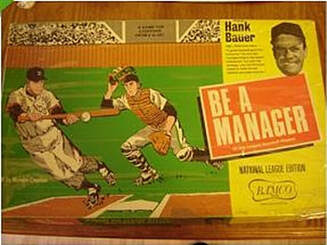 Board Games Continue To Rise In Value Board Games Continue To Rise In Value While big ticket items may be getting the lion's share of attention this fall, that doesn't mean that certain smaller collectibles aren't pulling their own weight when it comes to big sales. Don Badger, who runs a number of online concerns that were once devoted exclusively to sports memorabilia, has converted one of his websites over to a "board game only" presence, after discovering a vault of them (some in their original unopened packaging), at a garage sale. "I started to put a few of the Risk and Milton Bradley games on my auction sites, and they were gone in hours - usually over asking," says Badger. While he realizes that he's in an enviable position of having a massive amount of pristine stock, he's still amazed at the fact that some of the games he sold earlier in the Spring for $200 and $300 are now selling for double that in less than six months. "I have duplicates for many of the games, but the one's from the 1980's and earlier seem to be the most popular with collectors." 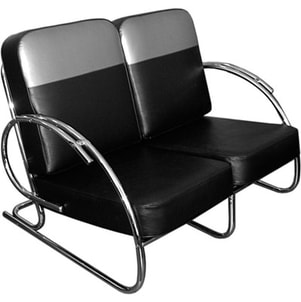 All Areas Of Art Deco All Areas Of Art Deco Riding a similar trajectory to board games, the public's seemingly endless fascination with almost anything "Deco" appears to be continuing with no end in sight, at least according Donna Sorvino, who blends a vintage boutique shop with an interior design business in Atlanta's Buckhead. "Most of what I'm seeing is younger people who are using Art Deco items as accent or occasional pieces in urban environments." Sorvino thinks that many of the city's buildings simply lend themselves better to Art Deco furniture than they do Mid-Century Modern. "It's really a choice I suppose, but over the last year, sales of Deco pieces have far outstripped my MCM inventory by a wide margin." Although she thinks her mid-century stock will still sell, she's now much more inclined to search out AD pieces than MCM. "The items I sold in the spring, I'd probably markup another thirty-percent today." For Sorvino, the sky's the limit, from small chests-of-drawers and sofas, to Deco influenced sculptures and smalls. "You name it," she says, "If you can attach Art Deco to the tag, it'll sell." 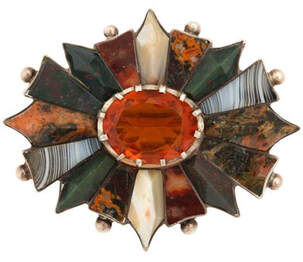 Antique Jewelry Returns To Fashion Antique Jewelry Returns To Fashion While noted earlier last year in Asia, the rise in the popularly of antique jewelry has apparently also made itself known to dealers on North American shores as well, with prices rising uniformly across the board throughout the year. Nigel Hill, a gems specialist from New York, who often represents major auction houses both here and abroad, says that while the buying frenzy for period correct antique jewelry probably started in the high-end Hong Kong auction houses a couple of years ago, the trend has now trickled down to everyday dealers. "We're getting far more collections from people wanting to sell, because they've suddenly become aware of the price increases due to the realized auction results," he says. Sandra Cooke, who owns an Etsy store and walk-in business in downtown Toronto, concurs with Hill's assessment. "Two years ago it was all about costume jewelry," she says, "Today, I'm only sourcing mid to late Victorian pieces like broaches, pendants and necklaces." Cooke says sales began to rise last year online, and by the end of summer, once Covid restrictions had eased, her store literally became full of urban hipsters on the search for older authentic pieces. "I'm as shocked as anybody," says Cooke, "but it's certainly nice to see some of these lovely antique pieces return to prominence." 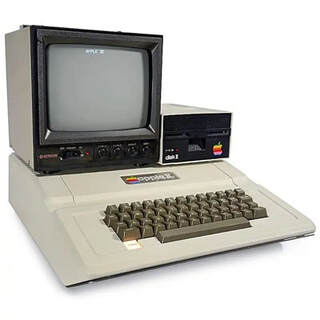 Early Computers Move Beyond Niche Collectors Early Computers Move Beyond Niche Collectors Electronics from the 70's and 80's are continuing to surprise collectors and dealers alike. Paul Talbot, who's been specializing in old Apple computers and vintage video games for more than twenty-five years, says that there's a strong market for full computer systems to vintage console games and even some magazines. Talbot says that it's not just the products themselves, but sometimes the components too. "I bought an auction-lot of semiconductor chips years ago that turned out to be the same ones used on the Apollo missions," says Talbot. "Today, those chips are selling for thousands of dollars." While Talbot is quick to point out that most stuff that was mass-produced during the latter half of the twentieth century is not collectible, items from the 1970s and 80s are. "Apple ll and Commodore computers are increasing in value rapidly," says Talbot, "Even the ones with later serial numbers are now fetching five-figures at auction." Talbot, who markets his wares online only, says that sales have been brisk since the pandemic, with prices rising commensurately throughout the year. "It's the best fall I've ever had, "said Talbot, "I'm just hoping it keeps up through the winter... and beyond." - A.I.A. Staff Writer's  NOTE: For readers seeking more information about the Asheford Institute Of Antiques distance-learning program on professional-level appraising, the study of antiques, collectibles, vintage and mid-century modern items, please click here to visit the school's Home Page. Should you have additional questions about the Asheford program, you can also write to the school at: [email protected] or call the Registrar's Office toll-free at: 1-877-444-4508.  Susan B. Anthony Portrait Found Susan B. Anthony Portrait Found New York - Buying a new home, especially an older one, can come with a variety of pitfalls. However, for one lucky New Yorker it also came with a surprise win - behind ceiling-panel number three - which led straight to the attic. For David Whitcomb, who bought the old century-home in Geneva, New York, last year with plans to convert the dilapidated building into a law firm and upper floor rental unit, the find came as nothing short of a huge surprise. Whitcomb related that while he was giving a friend a tour of his new purchase, he noticed a drop-down ceiling had deteriorated and was showing floorboards and rafters above it. He said he had no idea that there was a room above it, "It wasn’t in the paperwork," he said, "and we didn’t do an inspection because we knew the building needed to be renovated."  Photographer James Ellery Hale Photographer James Ellery Hale After some initial scrambling onto chairs, he and his friend managed to locate the entrance to the attic overhead (which they later determined had been sealed off for more than a hundred years), and discovered a virtual treasure trove of antiques, photographs and paintings that appeared to be the private collection of noted photographer James Ellery Hale. Whitcomb believes the attic was used by Hale as a studio, and says that so far he's uncovered more than a thousand antiques dating back over a hundred years, including an original print of the early feminist icon Susan B. Anthony, which is the same as that currently hanging in the Library of Congress. Other finds included furniture, photography equipment, decorative arts items, and a number of early twentieth-century portraits. 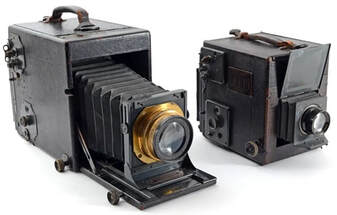 Early Camera Equipment To Be Included In Sale Early Camera Equipment To Be Included In Sale Whitcomb, an avid antique hunter himself said, "Everyone hopes to find treasure someday, and we actually did... it's incredible to think about." After realizing what he'd come across, Whitcomb brought in photography and history experts to examine and confirm many of the items. An adjacent building had caught fire during the 1980s, and according to Whitcomb, the attic was not only full of dust, but ash as well from the neighboring blaze, which made cleaning the pieces and bringing them back to their former glory painstaking work. Finally, after conferring with experts and authenticating the historical items, Whitcomb decided it was time to sell, and reached out to One Source Auctions to conduct the online sale. A representative from the auction house has indicated that the sale is anticipated to take place later this fall, with final tallies for the collection expected to reach well into the low six-figures. For the rest of us, it's just another reminder of why every nook-and-cranny probably deserves a second look! - AIA Staff Writers  NOTE: For readers seeking more information about the Asheford Institute Of Antiques distance-learning program on professional-level appraising, the study of antiques, collectibles, vintage and mid-century modern items, please click here to visit the school's Home Page. Should you have additional questions about the Asheford program, you can also write to the school at: info@asheford.com or call the Registrar's Office toll-free at: 1-877-444-4508. 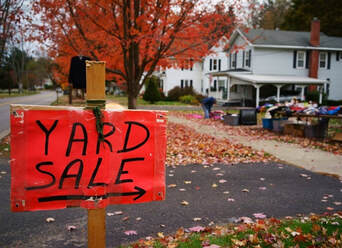 Quality Sales Return This Fall Quality Sales Return This Fall New York - One of the collateral effects of the recent Covid pandemic, which included lockdowns, has been the ability of many who were confined to their own four-walls, to not only tidy-up around the house, but to finally act on that long procrastinated promise of cleaning-out and clearing-out. With the additional time spent at home, people were able to sort, organize and prepare for disposal like never before. As restriction measures eased, and life began to return to some degree of normalcy, garage sale watchers began to notice an interesting trend; listings for garage sales suddenly began to explode in the early fall. 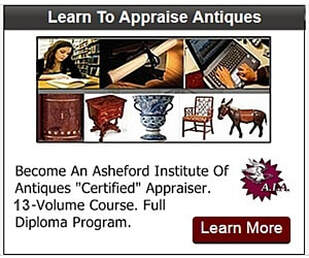 Grant Howard, a New Jersey native who runs a vintage audio shop on the outskirts of Newark, while also working part-time for an online garage-sale listing service, says that part of his digital responsibilities include aggregating sales listings for the entire state. "During Covid, the number of garage-sales were obviously way down," said Howard, "but as soon as the weather turned and restrictions came off, the listings began to steadily rise, and then spiked in early autumn." It wasn't just a rebound though, at least according to Howard, who says that weekend postings for neighborhood sales shot way up above what they were pre-Covid. "I'm a bit of a high-end turntable junkie," says Howard, "but finding good examples prior to the pandemic was getting difficult, now I'm coming across two or three in a single outing." Howard says that he's also noticed an increase in overall quality as well. "In years past, avoiding the children's-clothing sale was almost impossible, but since we've opened back up, I'm seeing all sorts of great collectibles and antiques that were often absent prior to the pandemic." 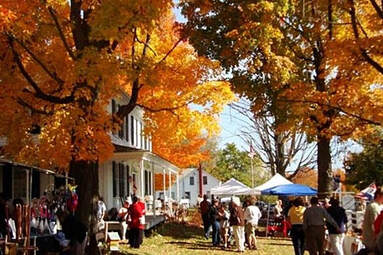 Autumn Sales Have Doubled In Some Areas Autumn Sales Have Doubled In Some Areas Other dealers also seem to be aware of the uptick as well. Sharon Miller, a vintage kitchenware aficionado, and part-time decorative arts blogger from New England, says that she cut down her weekend forays before the pandemic simply because they weren't returning any real value. "I was primarily looking for pyrex and mid-century kitchen pieces," says Miller, "but finding good examples was becoming increasingly hard." Miller noted that belonging to an online garage-sale board, was how she first became aware of the sudden increase in overall listings. By the beginning of fall, her neighborhood was experiencing twice as many sales as normal said Miller, but with a much better selection. "I was seeing a lot of good vintage items that I hadn't seen in years - including some valuable 30s era toys and jewelry." Miller thinks that many of the recent garage sales she attended were being held by first-timers. "These were definitely not your regular garage-saler types" says Miller, "the quality was just too good."  Boomers Continue Clearing The Clutter & Downsizing Boomers Continue Clearing The Clutter & Downsizing A quick scan of sites such as Garage Sale Tracker, Yard Sale Search, or Gsalr.ca, and it becomes plainly evident, even to even the most casual of observers, just how much the numbers have changed in recent months. Brad Morris, a dealer from Seattle, Washington, who keeps multiple garage sale apps on his phone from Yard Sale Treasures to G-Sales By Map, says that he can now only visit about a third of the sales he did before - which is a good thing - according to Morris. "Prior to Covid, I was doing a lot of drive-bys, but now I'm literally stopping at every sale along the way because the offerings are so great." Morris attributes the better quality sales to late-gen baby boomers continuing to clear the docket after Covid. "I've been to a lot of sales before on these streets, but these days the homes hosting the sales are new," says Morris, who specializes in comic books, musical ephemera and vinyl records. While finding those hidden treasures can still be a challenge sometimes, Morris admits that it's become a lot better recently as higher quality sales seem to be flourishing. "It started in the summer," says Morris, "but by the end of September it seemed as if there was literally a sale on every corner." For those selling primarily online, and who rely on "smalls" for the majority of their inventory, the resurgence of quality garage sales has been a godsend. Audrey Humbert, who manages an online discussion group related to vintage shops, says that her members have all noticed not just more garage sales per square mile recently, but sales that are also bigger in scope and encompass a greater selection of items. "I think the lockdown just gave some people the impetus to finally get organized and clear the deck," says Humbert. "For our members, it's meant an easier path to better inventory, and a wider assortment of items to choose from." How long this trend will last is anybody's guess, but judging from the plethora of current listings on Craigslist and Facebook, it would appear that there is still plenty of supply in the garage-sale pipeline. For Grant Howard, it's not really a question of supply-and-demand though, as much as it's about clearing the clutter. "People have already been living with this stuff forever," says Howard, "but then Covid came along and they were stuck staring at it twenty-four-seven for months... I think after that, I'd want it gone too!" - A.I.A. Staff Writers  NOTE: For readers seeking more information about the Asheford Institute Of Antiques distance-learning program on professional-level appraising, the study of antiques, collectibles, vintage and mid-century modern items, please click here to visit the school's Home Page. Should you have additional questions about the Asheford program, you can also write to the school at: info@asheford.com or call the Registrar's Office toll-free at: 1-877-444-4508.  New York - For many dealers of a certain age it seems just a few scant years ago that prognosticators everywhere were signaling the death knell of the antiques business. Opinions at every turn summed up the industry's demise with a sobering prediction that old would never return. But within a few short years, a new generation of buyers and sellers had suddenly appeared, and so did the predictions. For those who remember the antiques industry in the mid-nineties, the outlook couldn't have appeared more grim - stainless steel and modern motifs were on the rise, while 'brown wood' and anything associated with the last vestiges of the Victorian era were being ditched faster than a firehouse freebie-sale. However, after witnessing a decade of declining sales and changing tastes, a funny thing happened on the way to the antique market... Millennials began to take an interest in their past. Not the far flung past mind you, but the past associated with their parents and grandparents - the funky looking Danish credenzas in the living room and starburst clocks on the kitchen walls. Little by little, the interest spread upward and outward to include '60s bean-bag chairs and '70s space-age modular furniture, until by the middle of the 21st century's second decade, millennials had completely reshaped the collectible nature of the decorative arts market. For the older antique dealer this move marked what appeared to be a renaissance of collecting, but one that was hard to track and difficult to predict. Were the market changes real, or just a fad? Was the younger generations interest in the past here to stay or just a fleeting fancy? 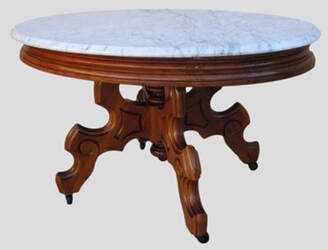 Antique Pieces Benefitted From The Overflow Antique Pieces Benefitted From The Overflow For most industry insiders the answer came around 2010 with the growing influence of massive vintage buying and selling sites such as Etsy and Bonanza. Recognizing the surging interest in collecting by the upstart millennials, many long-established dealers began to segue from period pieces to more consumer driven commercial objects from the midpoint of the 20th century onward. 'Brown' may have been out, but kitsch was in, and there was plenty of it to go around. Multi-generational dealer Susan Collier, whose parents had started their antique business in Portland during the 1970s, believes firmly that the early millennial generation not only single-handedly saved her parents business, but were also responsible for a renewed interest in authentic antiques (including brown furniture), as their search for mid-century modern and kitschy pieces also led them into rooms filled with wooden furniture from earlier periods, including the Victorian era. "At first, most of them were just looking for the vintage stuff from the 50s and 60s," says Collier, "but pretty soon they started to realize the value in picking up late Victorian pieces, which at the time we were almost giving away." Collier credits her father for anticipating the market change when he started buying up Mid-century furniture from garage sales at the turn of the century. Not all of the antique resurrection can be tied to millennial interest in the Mid-century motif though, at least according to Oliver Flynn, whose boutique interior design firm in Soho, New York, has been charting the rise and fall of decorative arts trends for almost thirty years. Flynn says his daughter, who currently manages the firm, noticed the 'repurposing' movement of antiques and vintage items beginning early in the century. "It started with the shabby chic and painted furniture trend," said Flynn, "and then progressed into areas like Steampunk and industrial." Flynn acknowledges that at first he was mortified by the changes people were making to authentic antiques, but knew it was a do-or-die proposition for the industry. "I really didn't like the fact that wonderful Victorian pieces were being painted a vibrant purple or two-tone blue, but that's what our clients wanted, and I think it saved a lot of wonderful examples from ending up on the scrap heap." Flynn's daughter believes that the millennial interest in repurposing and being environmentally friendly has also greatly helped the antique industry as a whole. "They may not be the antiques that my father remembers," she says, "but underneath all that paint, they're still there." 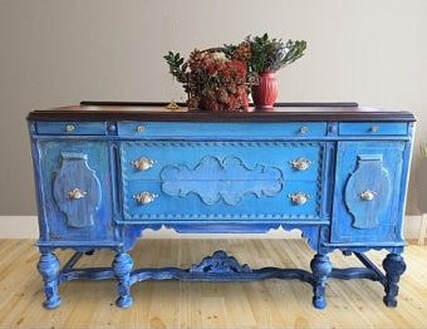 Vintage And Antique Pieces "Repurposed & Painted" Vintage And Antique Pieces "Repurposed & Painted" For Derek Jackson, who tracks decorative arts trends for Art Basel and a number of major auction houses, the proof is in the numbers. "You can literally see when the younger generation finally began to assert itself," says Jackson, who based the results of his study on online auction sites and realized sale prices. Jackson says that part of what he does is to develop algorithms that track decorative arts items coming onto the market and what they end up selling for. "There's no question there was a lull in traditional antique sales at the turn of the century," says Jackson, "but within the next ten years you could see it being replaced by the collectible and vintage stuff." What's really interesting about the numbers though, at least according to Jackson, is how traditional antiques have made a comeback with buyers who were originally simply purchasing vintage items. "I think once they started collecting, it became patently obvious that many of the older pieces were just too good of a deal to pass up." Today's vintage markets also seem to reflect a more balanced approach to stock then they did just a few short years ago. Tony D'Angelo, who's picked for dealers across the country for more than forty years, and who runs a part-time booth at the Brimfield shows, says that there was no question about what dealers wanted in the past. "Five years ago it was just MCM or vintage stuff from the 60s or 70s. Today, it's a little bit of everything, even Victorian." D'Angelo says he spends about six to eight months on the road buying and selling at shows every season, and admits that he's seen a big change over the last few years as vintage buyers search out not only the kitschy and retro pieces, but some of the older items too. "It's great to see antiques return," says D'Angelo, "before, a lot of the booths lacked any patina, but today most markets seem to have returned to a nice mix of both vintage and antiques... I'm just crossing my fingers that it stays that way!" - A.I.A. Writing Staff  NOTE: For readers seeking more information about the Asheford Institute Of Antiques distance-learning program on professional-level appraising, the study of antiques, collectibles, vintage and mid-century modern items, please click here to visit the school's Home Page. Should you have additional questions about the Asheford program, you can also write to the school at: info@asheford.com or call the Registrar's Office toll-free at: 1-877-444-4508. 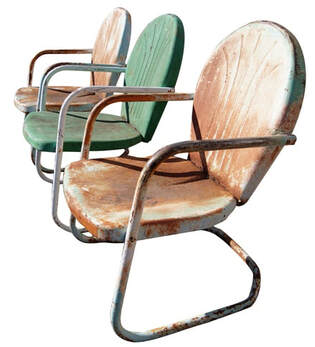 Vintage & Retro Garden Furniture Remains Hot Vintage & Retro Garden Furniture Remains Hot New York - Trying to figure out how the year's most popular decorative arts buying trends will shake-out in January, is never a good idea. Styles and design cues can seemingly change on a whim these days, but especially so as you move from the colder winter months to the more seasonal antique fairs and vintage markets of spring and summer. By then, many have often left the vestiges of last year's previous "hot items" (along with their winter coats), to be stored in the darkest recesses of attics and closets. However, for most in the antique and vintage trade, the vernal equinox is when the year's true trends start to emerge. To cut through the clutter of what appears to be popular, and what's actually trending, we decided to speak to a number of dealers and experts from varying disciplines within the decorative arts market to get their take on what's really shaking-out when it comes to this year's mid-season trends. 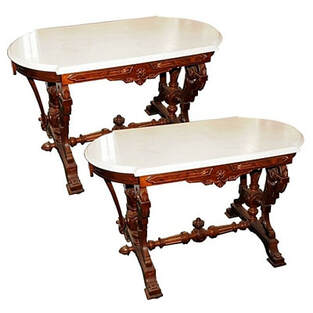 Marble-Topped Victorian Accent Tables Marble-Topped Victorian Accent Tables For Shelley Cates, a principal at a Connecticut interior design firm, it's all about the marble - not the round one's mind you - but the big thick white slabs that make up tables. "If we can find original Victorian washstands with the marble on top, it's usually gone before I can even text my clients a picture," says Cates. However, it's not only antique pieces that are in demand, according to Cates, but also seventies themed marble side and coffee tables. Also on the list are large travertine dining tables, which Cates says are extremely popular due to their high degree of resiliency against staining and general abuse. Lighter colors, such as white with black swirls, seem to be most popular with clients due to the overall neutrality of the stones appearance, as well as its ability to blend with both antique and contemporary furnishings. 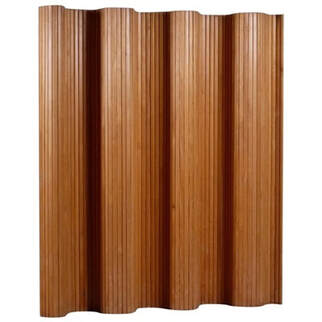 Mid-Century Room Divider Mid-Century Room Divider When it comes to vintage items, there appears to be a number of contenders, at least according to Eirka Jackson, who operates an online auction site devoted to everything mid-century and kitschy. "I normally stick to the small stuff," says Erika, "but this spring and summer, I've been buying up room dividers as fast I can - especially those with mid-century themes." Jackson believes the interest in room-dividers probably stemmed from people working at home during Covid who needed a way to break up the office space from that of the house. What Jackson finds interesting though, is how much the demand has continued - even after people have apparently returned to the office. "I think there's a lot of folks who are continuing to work from home, and will probably do so for some time, so it only make sense that demand for these items would remain strong." 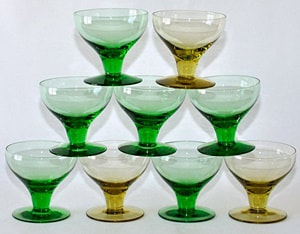 Mid-Century Cocktail Glasses Mid-Century Cocktail Glasses On a smaller scale, Jackson says that bar and dinner glassware from mid-century on, remains her top seller. Although she laments that complete sets of multicolored cocktail glasses from this era are literally becoming impossible to find. "I haven't been able to source enough inventory this summer to keep pace with demand," she says, "and when I do manage to stock up, the prices being paid at auction are just plain nutty!" Jackson believes that kitschy and mid-century kitchenware will continue to dominate the marketplace for the foreseeable future, especially with the younger generation she says. "They're my entire online client base - they'll often PM me before I can even list an item for sale!" 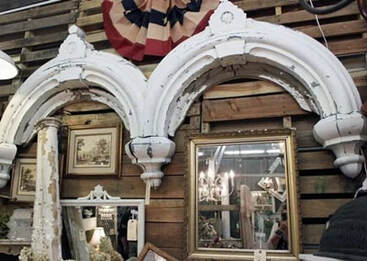 Strong Demand For Architectural Antiques Strong Demand For Architectural Antiques For Michael Behrs, architectural antiques and vintage garden furniture have continued to dominate his sales throughout the spring and summer. Based in Toronto, Canada, Behrs says that while the decorative arts market has been strong across the board in virtually every category, he's noticed that it's been particularly heady in certain segments that are directly related to the massive increase in home sales and renovations that occurred during the early part of the pandemic. "People were just spending so much more time at home, redecorating, renovating or buying second properties as a Covid-getaway," says Behr. "By the time these deals were sealed, there was a huge need for practical decorative arts items like interior columns, fireplace mantles, archways, fancy gates, etc." Behr acknowledges that he's in a particularly good situation, since he has plenty of land to store the large pieces, but says that even smaller decorative items in the main shop have also been selling quickly. "It's been my best summer yet," he says, "whether that's just an after affect of Covid or not I can't tell, but for now I'm just shipping and delivering as fast as I can." For a good number of dealers, it would seem that many of these trends that were originally prognosticated and brought to light in March, have continued to hold the line this summer despite some rather dramatic changes in the economy, Covid, and life in general over the last four months. Whether or not we'll see a surge of interest in something new, or a return to the quieting and settling down of longer lasting and more entrenched decorative arts themes remains to be seen. However, for many of the dealers and experts we spoke with, the old adage of, making hay while the sun shines, seems to be the mantra of the season. - A.I.A. Staff Writers  NOTE: For readers seeking more information about the Asheford Institute Of Antiques distance-learning program on professional-level appraising, the study of antiques, collectibles, vintage and mid-century modern items, please click here to visit the school's Home Page. Should you have additional questions about the Asheford program, you can also write to the school at: info@asheford.com or call the Registrar's Office toll-free at: 1-877-444-4508. 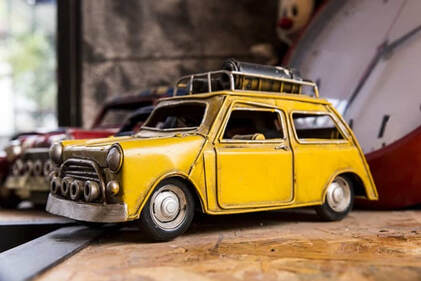 Rising Demand For All Things Antique & Collectible Rising Demand For All Things Antique & Collectible New York - It wasn't that long ago that many naysayers of the early 21st century were sounding the death knell for the antique and collectibles trade - but a funny thing happened along the way to the market. While prices did indeed drop for some traditional antique styles such as "brown furniture" and Grandma's china, a whole new group of collectors and collectibles suddenly appeared to take their place. The transition, while not occurring overnight, nevertheless became clearly perceptible to dealers and buyers alike, as Mid-century modern, textiles, costume jewelry, vintage 60s, and 70s modular, quickly became mainstays of the new decorative arts age. When Covid hit, many dealers were left wondering how this new resurgence in the antiques and vintage marketplace would fare during lockdowns and storefront closures. However, mid-way through the pandemic, to the surprise of many, dealers were reporting strong online numbers and solid curbside sales. For those in the industry, there was worry the success may have only been temporary, due to people staying at home and having little else to do other than peruse online sales and auction sites. However, this notion quickly changed as dealers across the country began reporting some of their best numbers to-date following the lifting of pandemic restrictions. 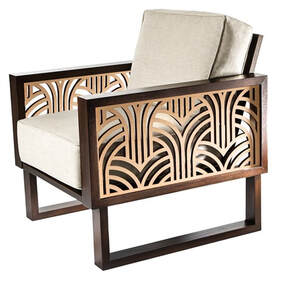 Finding Stock Becoming An Issue Finding Stock Becoming An Issue In Florida, one of the first states to roll-back Covid regulations, there was a sharp and consistent rise in overall storefront and online sales, according to Todd McMurry, whose brick's-and-clicks business near Miami's South Beach has seen it all over the last forty years. "It really reminds me of the roaring 80s," say McMurry. "When the pandemic hit, we dropped on floor sales but made up the difference online. Now that we're fully open to the public again, I can barely keep up with finding stock." McMurry says that while his inventory in the past mostly consisted of Art Deco pieces to match the surrounding areas architecture, he has recently begun to expand out to later mid-century and vintage pieces from the 70s. "It doesn't seem to matter what I put out there," says McMurry, "right now the demand is outstripping my supply." For others in the trade, the reopening of in-person antique shows and fairs has also seen a marked rise in customer interest in virtually everything related to antiques and collectibles. Donna Rice, a dealer/picker who covers the Texas and southeast circuit of antique and vintage fairs, says that prior to the pandemic there was always a steady stream of customers wherever she showed, but that now people are lining up at the gate sometimes an hour or two before just to get in. "I've never seen this kind of demand," says Rice, "People are literally scooping up my Fiestaware plates and 50's kitchen collectibles before I can even get them onto the shelves." Rice says she's not alone in noticing the uptick, "All the dealers have been doing really, really well." While pent-up demand from sitting at home during Covid probably has something to do with the rise in sales, Rice believes it's more than that, "Our online sales have also continued to stay strong, much stronger than even before the pandemic." However, it's not just about the sales reflecting a change in the marketplace, according to Rice, but the nature of the crowds too. "There's definitely a younger vibe to those attending the shows - it's almost like they're fed-up with Amazon ordering and are simply wanting to try something different." 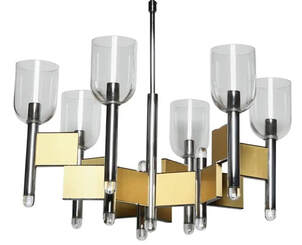 Mid-Century Remains Popular Mid-Century Remains Popular Roger Allison, a statistician and vintage-reseller who likes to analyze figures in his spare time, says that he's also noticed a substantial increase in the volume of online sales results from antique and vintage auctions sites that are related to his business. "During the height of Covid you could easily see how the number of realized-sales from auctions had climbed, but later, after the health restrictions were loosened, those numbers continued to rise," says Allison, "That's a pretty good sign the market is getting stronger." While acknowledging that his back-of-the-napkin math is only anecdotal, Allison, who lists across multiple platforms, says that the smaller auction sites can still provide a wealth of statistical information on the health of the industry to interested dealers. "The smaller sites tend not to charge for membership and often give out great sales results and data for free." As for his own business, Allison says that sales of his vintage and mid-century themed lighting have been booming. "I don't think I've ever seen a market as buoyed-up as this, says Allison, "I just hope it keeps going." For a lot of industry insiders, that's probably their biggest fear - is this kind of market sustainable? Many of the dealers we spoke with felt that in some respects Covid may turn out to be the catalyst that returns the decorative arts back to it's glory years of the 1980s. Not because of the nature of the pandemic itself, but because it forced people inside, and by association, onto their computers, where they had a chance to slow-down, contemplate, and possibly rediscover the past and the items that belonged to it. Todd McMurray, who remembers the decade well, says that while nothing is for sure just yet, he thinks it's about time for interest in the decorative arts to start hitting a peak again. "I've been at this for over forty years now," says McMurray, "and if my post-Covid sales continue to hold true, I'll beat my best 80s numbers by a long shot..." - A.I.A. Staff Writers  NOTE: For readers seeking more information about the Asheford Institute Of Antiques distance-learning program on professional-level appraising, the study of antiques, collectibles, vintage and mid-century modern items, please click here to visit the school's Home Page. Should you have additional questions about the Asheford program, you can also write to the school at: [email protected] or call the Registrar's Office toll-free at: 1-877-444-4508. 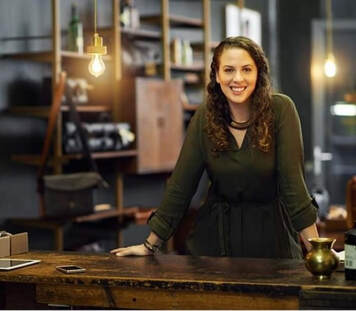 Millennials Tap Into Online Community Millennials Tap Into Online Community New York - It wasn't that long ago that many bemoaned the fact that millennials just didn't seem to be interested in antiques or anything old. But oh what a difference a few years can make. Fast-forward to the beginning of the twenty-first century's third decade, and millennials have literally become the driving force in today's antiques and collectibles marketplace. Sales of vintage items from online platforms have never been higher, and the resurgent interest in antiques and collectibles by a younger generation has suddenly become the norm, not the exception. However, what's been most startling about this recent generational shift has not been the interest-led move from the over-50 crowd, to twenty and thirty-somethings, but how millennial's have managed to transform the entire buying and selling process, as well as the customer base to which they're trying to reach. How such upstarts have been so adept at wedging their foot through the proverbial decorative arts sales door, may seem like a mystery to those of us currently pondering the need for dentures, but for the younger generation, hitting a successful stride in the antiques and vintage business simply came down to one all-important platform; Instagram. While Facebook's sister company certainly isn't new to the scene, it's how the "Gram" has been used and developed by millennials that sets it apart from the rest of the crowded online marketplace, and especially bricks & mortar companies. 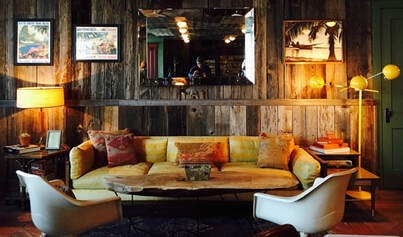 Not Just Coffee For Sale Not Just Coffee For Sale Devon Hall, who just turned thirty, and runs an organic deli/coffee shop, cum-vintage furniture business in Seattle, says that by incorporating her vintage items into her actual storefront setting, she's able to not only advertise her coffee business, but also her vintage wares. "I don't plug myself into traditional advertising sites or newspapers," says Hall, "because I'm solely on Instagram." By cultivating her IG followers, Hall says she's been able to build up a really solid base of connected customers, without having to fund an exorbitant advertising campaign. Hall claims that this natural approach to client-gathering has garnered interest not only in her products, but in her brand as well. "It's sort of like a two-for-one," says Hall, "people know my coffee, but they also know they can buy the chair they're sitting on - it's let our Instagram page become a virtual gallery." Many of the new millennial dealers say that selling on Instagram has an entirely different feel than other online related resources. Nancy Lee, an furniture restorer and vintage dealer with two shops on Etsy, says that overtime she's found that by carefully curating her followers, and DM'ing with people of a similar interest on Instagram, that her sales have become much more consistent than on Etsy alone. "Instagram is more of a community of like-minded individuals," says Lee, "Some of my followers are buyers, and some sellers, but there's much more of a direct connection between us than on any other platform." Lee thinks that pricing also has a lot to do with her success. "When you're acquainted with your followers, you're more likely to give discounts than you would to a make-an-offer request from a random stranger on sites such as eBay." While Lee notes that cutting prices can affect the bottom line, she says the volume of overall sales received from her Instagram clientele has easily made up the difference. "It can take a while to build up a solid list of connections," says Lee, "but in the end, it doesn't cost anything but time and interaction."  A Shared Sense Of Creative Expression A Shared Sense Of Creative Expression Some of Instagram's features can also apparently play a prominent role when it comes to millennial success rates - at least according to Peter Hodge, a Brooklyn art gallery owner who started incorporating vintage and mid-century themed pieces into his space after creating a dedicated Instagram business page for his gallery. Hodge says that features such as "Stories" can generate real walk-in business from his list of IG followers. "It's not like the old days where you set-up a web page blasting out hundreds of photo-items, while hoping for an add-to-cart click." Today, Hodge says it's all about building your presence within an online community. "IG lets me interact with clients and other shop owners in real time - there's a sense of creativity and sharing that goes beyond just generating sales." Anne Sayers, says she used to run a vintage booth in a flea market in the San Francisco Bay Area, prior to Covid hitting, but had to pivot quickly once lockdowns became the norm. "I hadn't really paid that much attention to Instagram before the pandemic because my business had always been face-to-face." However, Sayers claims that she soon realized there was a potential market in connecting with other booth owners who were also suffering from the shutdown. "I started to DM them on Insta and then moved onto setting up smaller curated groups where we could buy, sell, and trade with each other." Sayers says that after a while interest in the groups really began to take off, and so did her number of followers. "It's been kind of crazy," says Sayers, "One day you're worried about being shut down, and the next you're planning your own pop-up shows with people you've connected with on the gram." This communal sense of working together, whether it be collaborating on a pop-up vintage exhibition with other stores, sharing techniques for photo shoots, or collectively creating dedicated antique and vintage "groups" related to one's Instagram page, seems to be at the core of how millennials perceive the construct of doing business today. For dealers like Peter Hodge, it's a far cry from his father's furniture business of only twenty years ago, where everything was literally cut-throat when it came to the competition. "I think my Dad would literally take a turn-or-two today if he could see how we collectively benefit by sharing our resources and sales leads," say Hodge. "I've not only sold more through my IG connections than I ever did before, but I've also made some great friends along the way..." - A.I.A. Staff Writers  NOTE: For readers seeking more information about the Asheford Institute Of Antiques distance-learning program on professional-level appraising, the study of antiques, collectibles, vintage and mid-century modern items, please click here to visit the school's Home Page. Should you have additional questions about the Asheford program, you can also write to the school at: info@asheford.com or call the Registrar's Office toll-free at: 1-877-444-4508.  $5 Warhol Sketch Lists For $1.9 Million $5 Warhol Sketch Lists For $1.9 Million New York - We've all heard the stories before about the incredible discoveries and massive price realizations that can come from a simple happenstance stop-over at a local garage sale, but how often do these rare and valuable finds really occur in today's world of instant price-checks, and eBay comparison apps. For many antique and vintage dealers, the answer is surprisingly, more often than you might think. While most dealers will tell you that they're certainly not making "million-dollar" finds on a regular basis, many will acknowledge that they are still sourcing great inventory from the tried-and-true garage sale platform, despite the advances in technology that allow amateur sleuths and collectors to compete for the same items. 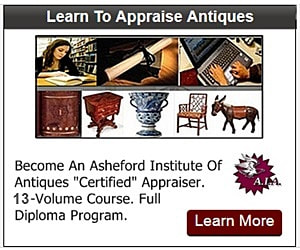 Even with the current Internet frenzy regarding the recent auction of a garage sale bowl that was bought for $35 in Connecticut, and sold at Sotheby's for just over $720,000, Mark Davies, an online collector and dealer in porcelain for over thirty years, says he believes that finds of this caliber, while still quite rare, are more common than people might know. "I haven't made six-figures, or anything like that," says Davies, "but over the years I've purchased multiple examples from yard sales that I went on to resell for hundreds of times more than what I paid." In some instances, Davies says that he's earned thousands of dollars off of items he found discarded at the end of a sale. "They were literally throwing the stuff out." says Davies. While not every outing can bring in such rewards, Davies confesses that if he had to add-up his best inventory finds over the last thirty years, hands-down, it would still be his picks from Saturday morning yard-sales that provided the most return on investment. 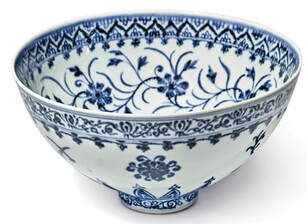 $35 Ming Bowl Sells For $722,000 $35 Ming Bowl Sells For $722,000 Many dealers acknowledge that sourcing out good quality items can be tougher today than in the past, since it's not only those holding the garage sale who are doing their research, but also the customers. Cheryl Oaks, an antique dealer from Irvine, California says that sales she attends today are littered with armies of phone-holders conducting online price-checks and and bid comparisons. "It's obviously not what you want to see," says Oaks, "but by the same token, I've found that a lot of people tend to get frustrated when they can't get quick and definitive answers, and will often leave an item behind because they're unsure about its actual value or authenticity." Oaks believes that a lot of this has to do with information overload. "They're not really professionals, they're just punters out looking for something to do," she says. "When they come across an item they can't readily identify, they become inundated with a slew of online examples, which tends to create uncertainty." Oaks says she's lost out a few times to the Saturday morning crowd, but in the long run, says that some of her best inventory still comes from garage sales, including some original Stickley Mission chairs she once picked up after a seller offered her a nominal fee to just 'haul them away.' 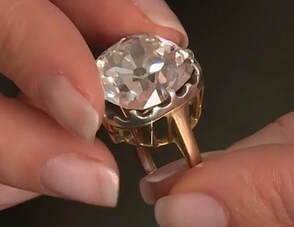 $13 Garage Sale Ring Valued At $500K $13 Garage Sale Ring Valued At $500K For others in the market, garage "saleing" has become more about strategy. Bruce Hodgson, an antique and vintage jewelry dealer from South Florida, says that over the years, even though he's developed a multitude of different systems for acquiring inventory, he keeps coming back to garage sales. "There's simply no replacing box-lots," says Hodgson. "Everyone can see a beautiful walnut table that was passed on down from Grandma, but what's often not seen are the pieces of family jewelry that just get dumped into the bottom of boxes." Hodgson says he can't recount the number of times he's come across rings and broaches thought to be worthless that ended up helping him set monthly sales records. "I'm very particular about what garage sales I go to," says Hodgson, "I plan my route around neighborhoods with retirees - the older the folks - the older the stuff." Hodgson also believes that having a lifetimes worth of experience in the jewelry business has helped him immensely when it comes to competition from the Saturday morning price-checkers. "It's not nearly as easy to identify a genuine piece of antique jewelry from a picture on a phone, as it is in person," says Hodgson. "You're definitely going to be handicapped if you can't bring some prior knowledge to the sale." While most dealers would likely agree that garage sale competition has been getting stiffer over the last ten years due to the publics increased awareness of 'value' items, many would also argue that there are simply more garage sales now than ever before due to the aging boomer population. For Mike Horlock, who has been picking sales in the Atlanta region for the last forty years, it's become a delicate balance. "Prior to the boomers disposing of their goods and chattels, most of what I found was headed straight to flea markets for resale - today, it's pretty much going straight to antique and vintage shops." Horlock says he would have been lucky to come across high-value garage sale items back then, but today, it's almost a common occurrence. - AIA Staff Writers  NOTE: For readers seeking more information about the Asheford Institute Of Antiques distance-learning program on professional-level appraising, the study of antiques, collectibles, vintage and mid-century modern items, please click here to visit the school's Home Page. Should you have additional questions about the Asheford program, you can also write to the school at: info@asheford.com or call the Registrar's Office toll-free at: 1-877-444-4508.  (Updated - July 13th, 2021) New York - While 2020 was an unprecedented year on many levels (many of which I'm sure we'd rather forget), there were still some positive take-aways for dealers attempting to anticipate the "buy" direction of this years decorative arts market. As we've done in the past, school writers again reached out to a number of industry experts and dealers for their thoughts and predictions on where to find this year's hottest antique and vintage trends. For many of the experts we contacted, there was a palpable level of agreement that Covid 19 had definitely had an effect on buyers choices over the last year when it came to the overall shopping experience. The most commonly held observation related to this experience usually came down to "purchases of size." Simply put, dealers across the board noted that large pieces requiring pick-up or delivery, and multiple levels of interaction with sales staff and in-person shopping, suffered last year due to the fear of Covid. While nobody would argue that the pandemic has left us completely, the recent mass vaccinations and full opening of the economy has shown some experts and dealers that this year's trends are turning out to be more about scale than style. 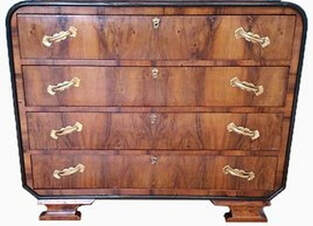 "Reimagined" 1960's Art Deco "Reimagined" 1960's Art Deco From Valerie Hopper's perspective, the craze over lamps during the pandemic, especially those in the Art Deco vein may still be popular this year, but notes that Deco furniture is currently stealing the show. "We had a number of customers putting down deposits on cabinets and chests last year, but waiting till this year for pick-up," says Hopper. "I was packaging and mailing lots of smalls in 2020, but to date, I'm already moving out big furniture pieces by a two-to-one margin compared to last year." While Hopper acknowledges that Art Deco seems to be all the rage at the moment, she also thinks that there's a pent-up demand for larger sized purchases in general. "Last year every nook of my floor space was crammed with case pieces, but thankfully, there are some noticeable gaps now." - V. Hopper (Antique Dealer) 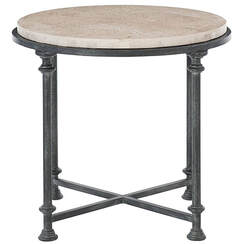 Travertine Table Travertine Table For those in the vintage environment, it may also be about scale as well, at least according Bridget Shaw, a veteran vintage dealer who retails from her barn just outside of New York. "We normally sell a lot of vintage garden furniture," says Shaw, "but last year it was pretty quiet, except for smaller decorative items and online sales." This year Shaw says requests for old marble and stone-topped tables has been through the roof. "In 2019 we began to notice an interest in older vintage wrought-iron and travertine style tables, but when Covid hit, it kind of dried up." Shaw thinks it wasn't so much an end to the trend, as much as a pandemic-pause. "Now that people are vaccinated, we're seeing a lot more in-store shopping for some of the bigger pieces that people were holding-off on." According to Shaw's log-book of requests from customers, there's definitely been a move towards the heavier look of wrought-iron pieces over the mid-century motif that she says dominated her inventory for years. "If I had to guess, I'd say the pendulum has finally begun shifting to shapes and forms that are more Victorian-esque than they are modern." - B. Shaw (Vintage Dealer) 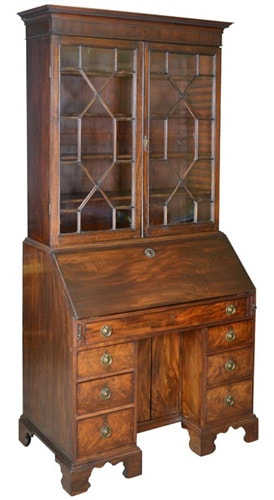 Revived Interest? Revived Interest? Other industry professionals also seem to have taken note of the change related to the scale of purchases. Chicago based Interior designer, Andrea Howard says many of her clients became reluctant to commit to a particular style last year, opting instead to wait until they could see where things were trending post-Covid before pledging themselves to a particular design motif. "We had a lot of requests for paintings, sculptures and objects d'art in 2020, but very little interest in full size makeovers that involved items like furniture." This year however, Howard says she's already seen a snapback to bigger decorative pieces and complete ensembles. Over the last few years heavily painted furniture had been popular with clients, according to Howard, but she feels the trend may have finally run out of steam. "People now seem to want more wood-toned pieces that perhaps reflect a stable and more traditional past." Howard says she isn't sure whether this nostalgia for a return to brown-wood is simply a reaction to people wanting to move past the pandemic, or a legitimate style shift, but notes that either way, the increase in customer demand for classically styled furniture has picked up substantially since the beginning of the year. "I'm not banking on a full return to the old days just yet," says Howard, "but I'm definitely going to be reaching out to my suppliers for an eyes-on approach, just in case it does return." - A. Howard (Interior Designer) 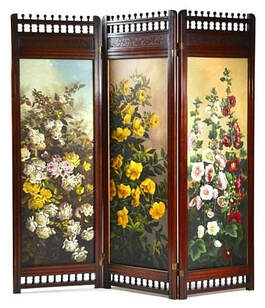 Room Dividers Back In Vogue Room Dividers Back In Vogue Adding to the trend towards "big," Etsy recently released its own in-house survey of buying habits, noting that with so many people now working from home in open spaces, that a demand for partial-privacy has quietly arisen in the form of full-sized room dividers. Remembered primarily as the domain of well-heeled Victorian homes, many antique dealers have also recently reported a strong uptick in interest in these oft-forgotten folding-panel-walls that were once a staple of virtually every Victorian boudoir. Tom Preston, who picks for dealers across the country, says that many of his clients are now actively asking for something he would often simply leave behind when collecting his box-lot purchases. "No one wanted these dividers a year ago," says Preston. "Now it's like a bidding war at every auction I hit." Overall though, Preston says the demand for dealers wanting to restock their inventories with larger furniture items seems to be coming back. "Last year I didn't really need my trailer for buying trips - this year I'm probably going to need a bigger one." - T. Preston (Picker) 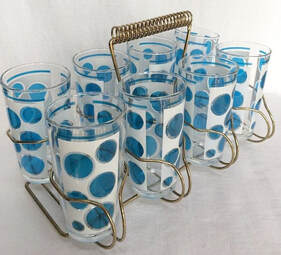 Mid-Century Barware Mid-Century Barware While many dealers and industry pundits are seeing a return to full-size purchases this year, Joanna Burk, a "glass specialist," with sites on Etsy, eBay, and a host of other collectible platforms, says it's not all about the "big." Burk claims that her sales of mid-century barware and pretty much everything party-glass related up to the 1970's, has been on fire over the last twelve months. "Maybe it's just because everyone was hanging out at home and starting cocktail hour early," says Burk. "Or perhaps it's just a renewed interest in an old collectible, I can't really say for sure, but I do know that I'm spending most evenings packing orders." Items such as colored glass tumblers with mid-century motifs or design cues from the 1970's (think white plastic wine glasses), are hot sellers says Burk. "Two years ago I couldn't move crystal glass, now I have a waiting list for any Art Deco crystal that comes along." - J. Burk (Online Dealer) For most of the dealers and industry insiders, the prognostication of this year's decorative arts direction wasn't just about whether or not trends ended up being in the big or small vein, but whether or not they could sustain some consistency moving forward. "I reckon we've got Covid pretty much in the rearview-mirror now," said Tom Preston, while returning back from a pick in Tennessee, "and because of that, people are back out shopping again, which means there's a good chance you'll see some of these trends really take hold and settle in for a good long while." - A.I.A. Staff Writers  NOTE: For readers seeking more information about the Asheford Institute Of Antiques distance-learning program on professional-level appraising, the study of antiques, collectibles, vintage and mid-century modern items, please click here to visit the school's Home Page. Should you have additional questions about the Asheford program, you can also write to the school at: info@asheford.com or call the Registrar's Office toll-free at: 1-877-444-4508. New York - What's in a name? For those of us in the decorative arts industry it would appear that the common-usage monikers of antiques, collectibles and vintage may have finally begun to merge. In a span of less than two decades, many collectors, buyers, and sellers of Victorian and stately Georgian pieces have quietly morphed their interests and purchases beyond the standard classics, moving collections and inventories into the broader and more contemporary range of early-20th century, mid-century modern and vintage themed pieces. These separate, yet somehow relatable classifications have in many respects been forced upon traditional dealers by the public's changing tastes towards the decorative arts over the last twenty years. Gone are the ubiquitous and all encompassing brown-patina "antique" pieces that were once a staple of literally every mid to high-end home of the last sixty years - now replaced by the sleek and angular lines of twentieth-century modernism. However, after more than a few decades of seemingly divergent lines of travel in meaning and scope, it would now appear that some of these decorative art terms have not only begun to run parallel to each other, but in some cases have even begun to merge. Initially, many antique venues at the turn of the century, fearing a loss of public interest (and business), through the use of the word "antique," pivoted quickly by adopting new monikers that included vintage and retro into their overall promotion and branding strategies. Other businesses even went so far as to create category specific words such as "Vintiques," to convey the changing direction they felt the decorative arts market had taken. Yet surprisingly, for many industry insiders, these terms have almost come full-circle, to the point of even becoming somewhat synonymous with each other. While purists may still count the years to officially denote what constitutes a proper antique, others have taken on more of a blended sensibility when it comes to what these expressions truly represent. 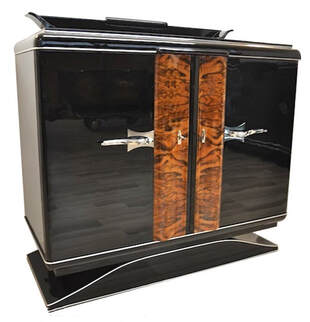 Art Deco Becomes "Antique" Art Deco Becomes "Antique" For a number of those working at the forefront of the decorative arts world, the blurring of lines has become almost too great to separate. Peter Thompson, a dealer just outside of Baltimore who runs an eclectic mix of old, and not so old, says he thinks items should be broken down by cultural themes representative of the time period, rather than just a blanket statement of age based on an accrued number of years. "I much prefer using the descriptor Art Deco Antiques, rather than simply classifying my inventory as a collection of early twentieth-century pieces." Thompson thinks the antique term continues to be relative though, but benefits from the style association. "I still believe that deep down most people associate greater intrinsic values with items termed antique than they do with just vintage or collectible." The seemingly arbitrary and somewhat singular nature of the term antique, other than it's use for classifying items one-hundred years or older for tax purposes, has perhaps run its course says Shannon Grey, an owner/operator of an antique and vintage jewelry business on Etsy. Grey believes that buyers have outgrown such restrictive and seemingly all encompassing terminology. "I think it's better to describe something that's more reflective of a style and time, rather than just saying it's antique or vintage," says Grey. While much of her inventory is spread across the twentieth century, Grey likes to define her stock by style first and date later. "I may begin with Art Nouveau, but I also understand that adding antique onto the sales-label tends to denote scarcity and rarity to my customers, which in turn, usually translates into a better pay-day." Grey isn't alone in her desire to attempt to restructure the terms that can often define one's business. David Howell, a second generation antique dealer from San Francisco says it really can come down to terminology. "Modifying the use of antique in my father's business name and replacing it with "Antique & Decorative Arts Sales," was probably one of the best moves we could have made," says Howell. "It changed the trajectory of our sales by bringing in a younger clientele that had a wider overall interest than just period-correct antiques." However, Howell also noted that being able to now apply the term antique to his substantial inventory of Art Deco pieces, because of crossing the hundred-year milestone, has also had its benefits. "It's added a tremendous amount of cachet, and inferred value, as opposed to just having a used or vintage moniker," says Howell. "Wording can make a big difference in customers minds when it comes to opening their wallets." So, has the "antique" moniker really been ostracized or suffered from call-out culture within the professional realm of the decorative arts? For the longest time, the term antique has generally been associated with the image of brown furniture, since anything prior to 1920 really didn't incorporate much in the way of truly modern construction materials. However, for many dealers, the recent resurgence in popularity of Art Deco, and its timely inclusion within the hundred-year club, may well be the reason for the return of the antique descriptor to its proper place of honor in the pantheon of decorative arts terminology. For David Howell, the answer is more straightforward. "When Art Deco became part of the family, true modernism fell under the 'antique umbrella' for the first time in decorative arts history." If Mr. Howell is correct in his assessment, then it may not be long before we're coining today's top collecting category as simply, "Mid-Century Antique." - A.I.A. Staff Writers  NOTE: For readers seeking more information about the Asheford Institute Of Antiques distance-learning program on professional-level appraising, the study of antiques, collectibles, vintage and mid-century modern items, please click here to visit the school's Home Page. Should you have additional questions about the Asheford program, you can also write to the school at: info@asheford.com or call the Registrar's Office toll-free at: 1-877-444-4508. 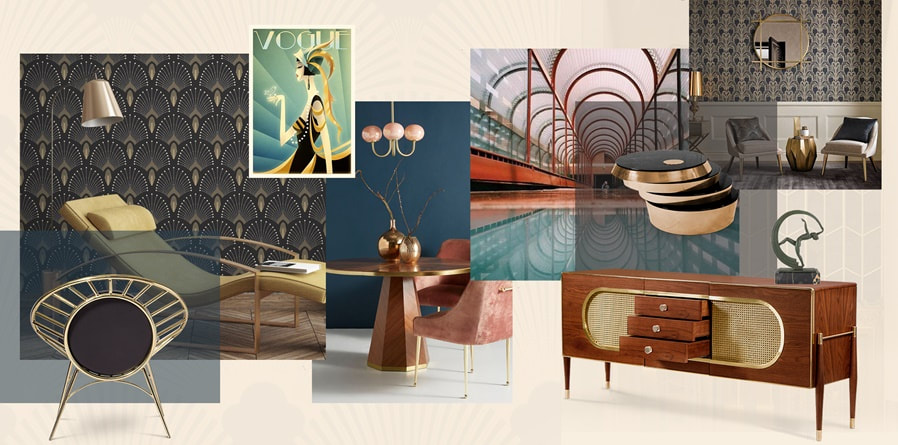 Florida - The Asheford Institute's latest results from its yearly annual survey of top buying trends within the antiques, vintage and collectibles marketplace has just been released. The Institute, which has been conducting the industry related survey on its graduates for over twelve years now, uploaded its latest trending data on decorative arts sales for 2020, via a dedicated page on the school's web site. While Covid 19 certainly had an effect on people's buying and collecting habits over the past twelve months, many trends from this year's poll remained the same, despite the pandemic. In other instances, new collector categories were added, with some surging in popularity as people found themselves spending more time at home and in front of their computers. Building on the results from last year's survey, 2020's poll offered an improved questionnaire that placed increased emphasis on compiling and grouping detailed information related to customers specific decorative arts buying habits over a twelve month period. Strong interest from past readers looking for updates to previous years statistics, prompted the change in format construction of the survey to include a broader base of information as it applied to the overall popularity of certain collecting genres within the antiques and vintage marketplace. "Despite the difficulties with Covid, we're continuing to ask questions that will hopefully further illuminate the specific sales categories and industry practices that have been most profitable for antique and vintage dealers over the past year," said Institute Director, Charles Green. "Being able to provide our students and readers with as much pertinent information as possible about what's selling in a particular geographic region, and how they can apply that data to help grow their own antique and vintage business has always been key to the survey." One of the main factors for the poll's continued success says Green, has been its steady increase in size. "The number of respondents queried has jumped year-over-year. Last year we increased the survey size by ten-percent, and in 2020 we upped that number by another nine-percent," said Green. The school's director believes the yearly increase in raw data compilation has greatly improved the accuracy of the poll's overall results regarding the popularity of particular sales categories within the antiques and collectibles community. "With each passing year the survey has not only grown in scope, but has provided a better picture of actual sales results within the marketplace itself," said Green. Anthony Harper, the school's lead researcher for the survey, echoed the director's comments about the revised poll format, while reiterating that the main objective of the Institute's survey has always been to provide as precise an analysis as possible of measurable interest in current decorative arts trends. Harper went on to state that the key to getting meaningful survey results was based on receiving actual sales data alongside item-specific requests from buyers, which could then be used to indicate interest within a particular collecting genre. Even though Harper has helmed the development of the school's surveys for over twelve years, he's still impressed at how well the results of past polls have managed to stand up over time. "When we first started out, we weren't sure if we were reflecting actual overall market conditions, or just a niche representation." However, since those first days, Harper said that not only did subsequent poll results reveal where the market was at, but more importantly, they often foreshadowed where it was going to be. "Over the years, I realized that was probably one of the most significant and valuable pieces of information to come from the poll," said Harper.  1970's Era Items Prove Popular (Globe On Lucite Stand) 1970's Era Items Prove Popular (Globe On Lucite Stand) Research staff from the school stress that while the current survey is based on a series of general questions, and non standardized statistical formulas, the results are nevertheless compelling when looked at in their entirety. “Sometimes a trend just appears out of the blue," said Amber Shole, a research assistant on the school's polling team. "Last year's collectible craze over everything space-related took us by surprise, said Shole, "but this year, it's an old favorite that has suddenly returned to prominence with both collectors and buyers alike." Shole believes that while this year's top antique and collectible ranking wasn't as much of an outlier as last years, it was still a surprise - managing to climb from worst to first in a little under a year. As past surveys have shown, there are always going to be a few perennial poll favorites, like Mid-Century Modern and Costume Jewelry, but Shole notes that changes are happening faster than expected. "We've seen the softening of the Mid-Century motif as trends continue to shift to less austere designs, and more comforting wood palettes begin to return." While Shole admits that Mid-Century items continue to be hot with younger buyers, she says that older more established areas of collecting are beginning to gain back some ground. "Last year we saw millennials starting to look at Victorian items, and buyers along the east coast show renewed interest in formal pieces from the Georgian period." While the school's 2020 poll may have been skewed slightly by the effects of Covid and temporary lockdowns, Shole believes that despite these shortcomings, this year's survey clearly demonstrates that trends can literally pop out of nowhere - even during a pandemic. "What we've seen over the last few years are not only younger dealers, but younger buyers as well. They tend to set the stage for new trends, and once in motion, they seem to find a great deal of traction with the buying public." For readers seeking the full results of the school's current 2020 decorative arts survey/poll (including this year's winner), you'll find it by simply clicking on the link below... Link: **TOP SELLING ANTIQUE & VINTAGE CATEGORIES FOR 2020** - A.I.A. Staff Writers  NOTE: For readers seeking more information about the Asheford Institute Of Antiques distance-learning program on professional-level appraising, the study of antiques, collectibles, vintage and mid-century modern items, please click here to visit the school's Home Page. Should you have additional questions about the Asheford program, you can also write to the school at: [email protected] or call the Registrar's Office toll-free at: 1-877-444-4508.  New York - To say that everyone is a little fatigued from the whole Covid nightmare is probably the understatement of the year. After months of lockdowns, openings, closings, reopening's, and everything else in between, most have just come to the conclusion that it's simply down to a waiting-game for a vaccine. However, even with the uncertainty this pandemic has brought over the last ten months, businesses have managed to go on; for worse (and surprisingly for some), for the better. During the pandemic's initial outbreak back in March of this year, staff writers contacted a number of antique and vintage vendors from across the nation to try and pin-down how they were feeling about their prospects for the upcoming year. While many of them were obviously tentative and filled with a certain degree of apprehension due to the nature of the pandemic, some had already pivoted their antique and vintage businesses to a different model by the beginning of May. This past week we returned to chat with many of these dealers to find out how their 2020 year was closing out... 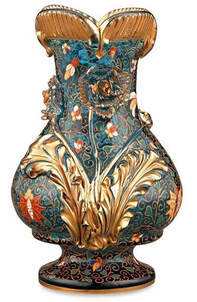 Art Glass Art Glass Calvin Smith, a second generation antiques dealer on the upper east coast near the Maine border, told us in March that he'd seen a lot of nostalgia buying at the onset of the pandemic. "I think people were just settling in for the long-haul," said Smith when we spoke to him last. "I don't really think anyone truly believed it was going to go on this long." Smith says that while he ramped up his online sales in the early spring to prepare for the lack of in-store shopping, he was pleasantly surprised that by the time summer came, he was actually able to have foot-traffic within his premises. "I don't know whether or not people were fearful of another lockdown, and maybe not being able to get back out, but they just seemed to be a lot more serious this year about buying rather than browsing. We didn't sell a lot of furniture, but higher end carry-away items like art glass and objects d'art really sold well." Smith claims that although his foot-traffic was down by more than forty-percent, he still managed to recoup eighty-percent of his instore sales, and made up the difference with his online efforts of smaller more packable items. "I can't really complain," says Smith, "I'm probably going to be up by about ten-percent at years end, so I'm pretty happy with how the season turned out so far." 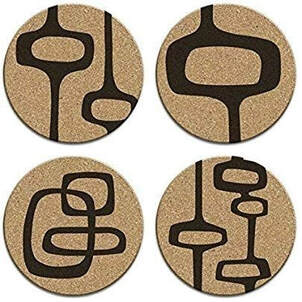 Mid-Century Modern Cork Drink Coasters Mid-Century Modern Cork Drink Coasters When we spoke to Harold White, a longtime dealer in Texas at the end of April, he and his daughter had just taken down the plywood coverings from the storefront windows and were reopening. White had battened everything up in March, but decided to open again once he saw that Covid numbers were relatively low in his area. "I probably wouldn't have done it without my daughter," said White, "but she convinced me that in addition to the shop, an online store might help fill in the gaps." White says that although there was a definite drop in foot-traffic, the new online venture did well. "I had old kitchen items from the 50's that had sat around for years, but as soon as they went on the Internet, they were gone in a day or two," said White. His daughter, who also took on the role of bookkeeper, says she thinks her father's business will be close to last year's numbers in terms of sales because of the new online presence. White says that while he's thankful to have pulled through the past few months with relatively good sales, he's also worried about future inventory. "They just don't have the in-person garage and estate sales like they used to," says White, "it's getting harder and harder to find reasonably priced items to resell" 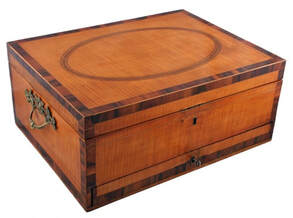 Accent Pieces - Sewing Box Accent Pieces - Sewing Box Not everyone we spoke to though had the same experience. Tim Clark, a semi-retired dealer from Birmingham, Alabama who owns a small storefront with mixed hours, said that he gave it a try for the first couple of months, but ended up going to appointments only, and moved into full-time appraising as way to make up lost ground. "I just found that even though the restrictions were pretty light here, most folks just didn't seem to want to venture out too far, nor for too long." Clark says that while in the past he could often count on browser-types eventually settling on a piece, this year they were in-and-out without so much as a by your leave. "I think people were just scared to linger," he said, "and the one's who did buy were usually looking for small accent pieces they could carry home with them." One positive that Clark says did come about as a result of his 'appointment only' theme, was an increase in people wanting appraisals done. "I was able to arrange for drop-offs at the store, which allowed for far less direct contact with people, but it also saved me time and travel expenses." Overall, Clark says he'll likely break above even this year due in large part to his added appraisal services.  Modular 70's Plastic Chair Modular 70's Plastic Chair In states where restrictions were lifted early in the pandemic, many antique and vintage businesses reported early numbers that were in line with previous years. Janet Williams, who manages an old red-brick grainery converted into a large antique and vintage storefront in rural southern Georgia, said that although her initial concerns about working during the pandemic centered on crowd and vendor controls, the process actually worked out quite well once they had a procedure in place for letting people in. "When we capped the number of people entering the business at any one time, we actually found that overall sales went up." Williams attributes this to the fact that people were more serious about buying, and weren't just congregating there on the weekends looking for something to do. "It was definitely smaller stuff that was selling; things that didn't have to be delivered." According to Williams, sales covered the spectrum from mid-century chairs and artwork to seventies style modular pieces and rounded chrome lighting. "It was truly a little bit of everything." Williams thinks that people came with a purpose, instead of a 'browsers' mindset, which she believes is what accounts for the surprising uptick in sales. "In March I was considering retiring, and yet by the end of December, we might end up actually being ahead of last years sales... it's really kind of hard to fathom," say Williams. For many of the other dealers we spoke with, 'digital' Antique Shows became the norm very quickly as the pandemic progressed, as did online auctions. By one account, the number of new dealers using their own auction software, or participating in collaborative online auction venues rose by a staggering 700%. Most dealers acknowledged that the move to digital representation in one form or another was the biggest reason for survival, and in many cases, continued growth within the industry. Robert Foley, a dealer from New York whom we spoke with in April, perhaps summed it up best when he explained that his first foray into online sales had just occurred in January, prior to the pandemic. "Today," he said, "I'm conducting and overseeing around four online auctions a week - I know it sounds crazy, but this may turn out to be one of my best years ever!" A crazy year indeed. - A.I.A. Staff Writers  NOTE: For readers seeking more information about the Asheford Institute Of Antiques distance-learning program on professional-level appraising, the study of antiques, collectibles, vintage and mid-century modern items, please click here to visit the school's Home Page. Should you have additional questions about the Asheford program, you can also write to the school at: [email protected] or call the Registrar's Office toll-free at: 1-877-444-4508. 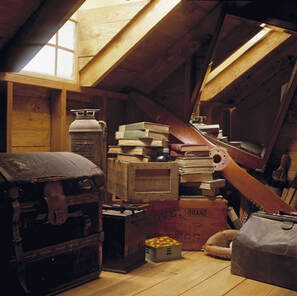 New York - While we're all aware that 'hoarding' is probably not the best practice when it comes to most things in life, there are of course exceptions to the rule. Often, simply retaining bits and pieces from the past is way of remembering something pleasant from another time. While an item may have outlived its current usefulness, or is no longer representative of a fashionable trend, it may still have a sentimental value to its owner. For those who hold emotional attachments to things collected long ago, the attic is often the final resting place for many of these items. However, before you decide to permanently lock the door to your mansard room, or cart your dusty old stash of attic boxes off to the nearest Goodwill, you might want to take note of some surprisingly valuable items that can often be found lurking just out of reach in the shadows above your head. While most of these top-floor items likely won't rise to the level of "national-treasure," you might just be surprised at how valuable some attic finds have become. 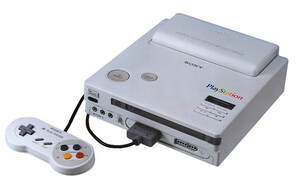 While not quite on everyone's collectible-radar just yet, tech from the 1980's has recently become popular with not only baby-boomers, but young millennials as well. Video game consoles from the eighties are commanding big bucks, especially when they include original packaging or have not been used. Rare editions will also add value. A Nintendo PlayStation prototype shown here sold at auction in March 2020 for an astounding $360K. While not all video games will draw such sums, you can usually expect a wide range of pricing from between $50 to $5,000. 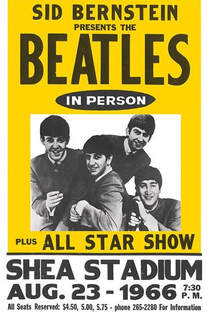 Among the top contenders for items in the attic are paper collectibles such as books, letters and posters. Baby-boomers have a penchant for hanging onto their musically inspired youth and adolescent bedroom wall-art with a vengeance. Concert posters from the 60's and 70's can draw large sums for the right bands. Of course condition is king, and having the poster properly mounted or framed will add considerably to the value. A 1966 Shea Stadium Beatles concert poster similar to the one pictured here recently sold for $137,000 earlier in the year. Bigger named bands will also get you a bigger paycheck should you decide to sell. Values on average can range from $25 to $1,500, and possibly higher if put up at the right auction. Newer bands, and album promotion posters from music shops and vendors can also bring in substantial sums. An original 1991 vintage poster featuring Nirvana's iconic "Nevermind" album was recently listed for over $200 by an online seller. 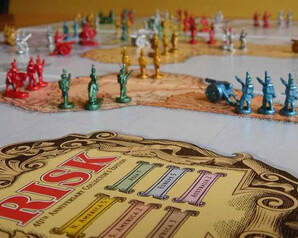 Another common item you're likely to find in many peoples attics (at least for those of a certain age), are board games. Even though Risk was first introduced in 1957, an anniversary edition that was released in 1999 now has an asking price well over $350 on eBay. Similarly dated games from around the turn of the century, such as the Star Wars, Queen's Gambit game are now valued upwards of a $1,000. As with most collectibles of this kind, unopened examples will take the highest price. Top titles are the most popular with prices ranging on average from $45 to $1,200. Other more commonly available examples like Milton-Bradley's, Fireball Island game, which dates back to 1986 is also highly collected due to the nature of the pieces involved - marbles that can be thrown at an opposing player's pieces! Finding one with all the bits intact can be worth well over $400 to the right buyer. 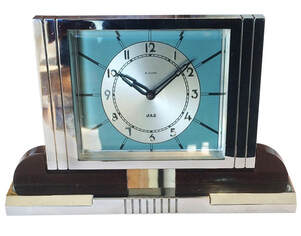 The rise of small wall and desk clocks probably hit its peak during the Art Deco and early Mid-Century period. The style of these time pieces reflected the architecture and design cues of the day. Geometric shapes, metal banding and rounding curves were all part of the aesthetic. There are many examples out there, but if it's been sitting in the attic for a considerable amount of time, make sure the cord or plug hasn't become frayed and brittle. Top dollars go to those that not only work, but still keep accurate time. Expect prices in the range of $35 to over a $1,200 for exceptionally good examples of commonly produced models like those from Westclox. Prices for high-end French Art Deco models can easily top $10,000, with Mid-century examples now reaching into the four-figures as well.  While we may have already beaten this collectible with a proverbial stick in the past (pun fully intended), it's almost a top-to-bottom dollar bet that you're going to find a few of these lying around in many of today's attics. Generally speaking, most won't be worth a fortune, but the older cards will often carry some value. In this instance, condition, player, and year will be paramount. If you stumble across something boxed and sealed, don't take a chance - have them professionally appraised. Values can range from almost worthless into the millions of dollars. Also, be advised that what you think may be "mint" condition, may only only be "excellent" in the eyes of the buyer. The difference between mint and excellent can be almost half the value of the card. 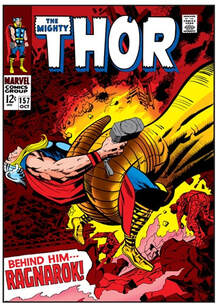 Another fan-favorite when it comes to incredible attic-finds are comic books. As with baseball cards, comics are going to be almost as ubiquitous in a homes upper floors as attic dust. Similarly, condition is key here, as is rarity and limited and early editions. Marvel Films, which are based on many of these original comic book franchises have been hugely successful and are pushing up the value of even modest condition examples. Rare copies can generate sums in the millions, but even more pedestrian comic books can run into the hundreds to thousands of dollars. Marvel's recent release of the film Eternals, also drove the price of an untouched first-edition from this franchise to over a $1,000, so keep an eye-out for upcoming new films that might be a match for what's in your attic stash. 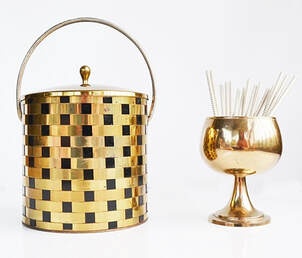 It's not just Mid-century modern furniture that's gone loco over the last ten years, but also any kitchen related items associated with the era. Fifties style cocktail sets and barware lead the pack, and can often be readily found in many of the attics of ranch style homes and bungalows representative of the period. Selection is generally still abundant, but certain styles from better known producers of the time such as Culver, Libbey, Tura and Hazel-Atlas are all being snapped up at ever-increasing prices. Glasses and barware are items often saved by people in case of "additional" need. Prices are across the board and can range from $10 to over $1,500 for popular examples. If you're unsure whether or not your attic barware meets the mid-century criteria, try some some searches online to match patterns and shapes. 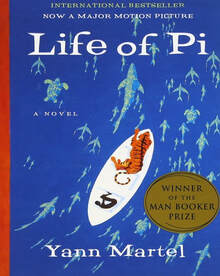 Of course no "Best-of" attic list would be complete without the granddaddy of upper-floor finds... books. For most of us, boxes of books are simply part of the attic aesthetic - it's simply where they go once they've been read and retired from the bookshelves. However, what many in the digital age may not realize is there's still a very strong market for certain types of books. One of the most popular and critically acclaimed books of the last two decades, Yann Martel's, Booker Prize winning, The Life of Pi, is also one of the most highly collectible (providing you've got the right edition). The Canadian Alfred A. Knopf editions are the copies most valued, and can sell for over $2,000. Of course condition, author, and subject can all play into value, so you really need to know whether the edition you have is worth anything (hint: check with your local book seller first). However, with the value of some titles, such as Julia Child's first 1961 cookbook selling for over $2,000 recently, it would certainly behoove anyone with a fully stocked attic library to do a self-check of their publication titles and of course any first editions. As with any rummaging expedition, attic finds can also produce some duds along the way. Sometimes an old plate is just an old plate. However, people often take great care to store things up high-and-dry, and out of harms way, because deep down there's a belief that what they have might be valuable in some way - whether sentimental or otherwise. So, if you haven't headed-up to the top floor in a while, it may just be time to break out the flashlight and listen to your gut once again. - A.I.A. Staff Writers  NOTE: For readers seeking more information about the Asheford Institute Of Antiques distance-learning program on professional-level appraising, the study of antiques, collectibles, vintage and mid-century modern items, please click here to visit the school's Home Page. Should you have additional questions about the Asheford program, you can also write to the school at: [email protected] or call the Registrar's Office toll-free at: 1-877-444-4508. Collectors Driving Up Antique & Period Jewelry Prices  Antique Period Jewelry Shines At Auction Antique Period Jewelry Shines At Auction New York - For many of us, contemplating the latest market fashions and tastes occurring within the antique and decorative arts industry may seem like a bit of a stretch at the moment - especially as the west and much of Europe continues to struggle with the effects of Covid 19. However, stunning results from a number of high-end auction sales in Asia recently appear to be turning a blind-eye to the pandemics stagnating effect on commerce, as a once famous and exceptionally popular decorative arts genre seems poised to be making a comeback with collectors and dealers from around the world. Or, as Hong Kong, Arts & Crafts dealer, Nigel Connally mused while attending one of these sales, "Antique jewelry is back baby!" Connally, and other top dealers who were rep'ing the local Hong Kong decorative arts scene, said the recent auctions put on by Phillips and Sotheby's were literally mayhem with so many dealers and collectors from across Asia unexpectedly showing up. "I just had no idea how popular late Victorian and Belle Époque jewelry had become," said Connally. "We were literally falling off our chairs at some of the prices being realized." The Sotheby's sale featured an art deco emerald and diamond-set necklace made for American socialite Hélène Beaumont, who was a close friend to Wallis Simpson, the Duchess of Windsor. Reported pre-auction estimates were pegged at around $1.8 million, but the early twentieth-century piece ended up being hammered-down for a staggering $3.6 million to an Asian buyer - more than double what it brought when last at auction. According to Jean Ghika, global head of jewelry at Bonhams auction house, sales of top-shelf late antique Victorian pieces and almost anything art deco has become exceptionally popular with Asian buyers. “There is an understanding and appreciation of these older pieces and the fact that many come with history, are unique, and often produced in limited numbers,” said Ghika. As for favorites, Ghika says that Asian buyers seem particularly enamored with pieces from famous French and Italian jewelry houses such as Van Cleef & Arpels, Cartier, Buccellati and Bulgari to name a few. 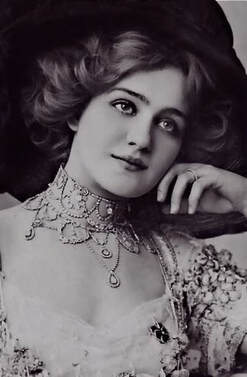 Belle Époque Jewelry Sells Out Belle Époque Jewelry Sells Out Echoing these statements, Graeme Thompson, who heads the global division of jewelry at Phillips auction house has also noticed a strong influx of interest in antique jewelry in not only China, but across Asia. “Jewels from the early 20th century, particularly the Belle Époque period, are becoming very popular," he said. Thompson noted that ten years ago he'd witnessed a stunning art deco diamond-set necklace by Cartier fail to sell at a Hong Kong auction. As fate would have it, he came across this same necklace this past year and consigned it to a Phillips sale, where it promptly sold for double its previous auction estimate. "It was at this point that I realized antique and period jewelry was becoming highly sought after in Asia,” Thompson said. A mix of more knowledge, and a tremendous amount of disposable income is apparently at the root of Asia's newfound interest in antique and early twentieth century jewelry says Harvey Brown. "Our shop in San Francisco has been dealing in these types of items for over fifty years, but recently prices have started going through the roof." Brown says that he started getting calls from Asian dealers last year looking for late Victorian and Deco pieces on a fairly regular basis. "I didn't put two-and-two together until I realized we'd sold out of every Deco piece we had." Brown went on to say that it wasn't only his shop that experienced the sudden interest in all things 'antique,' but that many of his picker friends and other dealers from up and down the west coast were beginning to notice a scarcity of available stock. "This craze may have started in Asia," said Brown, "but I can assure you that we're hunting down and adding late Victorian and early twentieth-century jewelry to our shop just as fast as we can." Whether or not this movement towards more traditional craftsmanship and older forms of jewelry will come to dominate the decorative arts market for the average antique dealer or collector remains to be seen. However, one thing is certain. A better 'worldwide' understanding of rare gems and the artistry behind such creations has fostered a new confidence amidst a growing group of global buyers. There are now legions of well-informed collectors prepared to pay top prices to obtain the finest antique examples at auction, regardless of whether or not there's an eventual return on investment. For today's antique dealers, buyers with pockets as deep as these are simply a dream come true. - A.I.A. Staff Writers  NOTE: For readers seeking more information about the Asheford Institute Of Antiques distance-learning program on professional-level appraising, the study of antiques, collectibles, vintage and mid-century modern items, please click here to visit the school's Home Page. Should you have additional questions about the Asheford program, you can also write to the school at: [email protected] or call the Registrar's Office toll-free at: 1-877-444-4508.  New York - Flight is fascinating – for all people of all ages - even in times such as these. When we see an airplane overhead, we often think of exotic travel to far-away places, especially as many of us are forced to continue hunkering down due to Covid 19 travel restrictions. We are reminded of our favorite vacation, or that adventure we’re still planning. Even when we understand the physics and mechanics behind flying, there is still a mystery surrounding the airplane. It is this fascination - and subsequent associations - that can often make the acquisition of vintage and retro aviation collectibles such an exciting and profitable pursuit for many of today's collectors and dealers. In years past, aviation related items had for the most part been the domain of a niche group of buyer's and sellers, but today that interest has begun to spread more broadly across the decorative arts spectrum, with a contingency of mainstream dealers taking note of the value in adding such items to their inventory or collection. While there is still currently plenty of available stock to choose from, some antique and vintage dealers are already sounding off on rising prices and "buy-it-now" auction results that show a dramatic uptick in overall demand (and cost) for anything aviation related. Mankind has only been flying for a little over 100 years, making true aviation antiques (by the strictest definition) few and far between. Luckily, the public took to flying like the proverbial duck to water, and an industry arose which gave us a plethora of interesting vintage and contemporary collectibles. In fact, there is hardly an area of aviation collecting that has not experienced a surge in growth over the last few years when compared against more mainstream collectibles. Whether this is due in part to the public's romanticized association with the glory days of flying, when passengers dressed in suits, and leg-room was ample (regardless of seating-class), or because people just seemed a bit more civilized when it came to travel back then, there is no question that today's vintage buyers have become completely enamored by the allure of yesteryear's aviation collectibles, as evidenced by the quickly escalating (and often realized) auction prices for many of these items. While the collecting of actual airplanes is best left to Hollywood superstars and James Bond villains, model and toy planes were made by just about every manufacturer in the world. Wooden, tinplate, and die-cast metal examples can be found, with the older models of course commanding the highest prices. As always, condition is key, as the propellers on small toys were easily bent or broken. It will be interesting to see if advances in 3D printing will allow for affordable restoration of these pieces as current prices and valuations continue to rise - even for modest examples. For those who prefer ephemera (printed matter), there are no limits to the collectables on offer. The 50’s and 60’s were the glamour days of airline travel, and posters, maps, and advertising materials of the time boast fantastic graphics and colors (think “Mad Men” meet “Catch Me If You Can”). The names of the airlines and the advertised destinations are what dictate the prices here, with Pan Am, TWA, and BOAC (the forerunner of British Airways) leading the pack. With popularity, however, have also come the reprints and fakes, so be sure you’ve got a reputable source when buying. 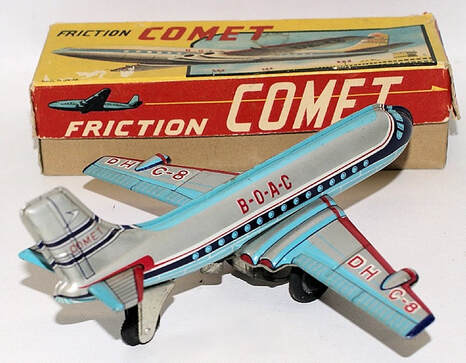 1950s Japanese BOAC Tin Litho Toy. Value $200. 1950s Japanese BOAC Tin Litho Toy. Value $200. Something larger perhaps? For fans of the industrial look, or those furnishing a “Man Cave,” an aircraft propeller mounted to the wall can give the room its final touch. Remember; real propellers are only curved (“cambered”) on the front side of the blades, the backs are flat. Additionally, any maker’s logos or stickers would have been printed along the blade – not across. Cheap reproductions abound, and they often get these details wrong. I’ve also seen airplane seats used in home theaters, catering trollies converted to mobile bars, and entire wings upcycled to conference room tables. With some imagination, the possibilities are endless. So far, we’ve only talked about the rising interest in airline and travel collectibles. Naturally, there is also military aviation, from its early start in WWI right up to the present day. Collectibles in this area include: uniforms and medals, aircraft parts (sometimes showing battle damage), pilot handbooks and logbooks, as well as all manner of personal equipment. As with all militaria, you want a complete history if possible – the where and when are almost as important as the objects themselves. In short, there are collectors for and of all things airline and aviation-related. I’ve met collectors of; pilots’ wings, baggage tags, cockpit instruments (clocks being the most popular), stewardess’ hats, propellers, safety instruction cards, route maps, radio sets, airline glassware and cutlery, posters and advertising, and everything in between. And yes, there is even a serious group who collect airsickness bags (unused, of course!) Air travel today may not be the glamorous adventure it once was on the Pan Am Clippers, but we all want it to be - especially during today's unsettling times. However, adding that aviation collectible to a room or a display cabinet may be just what's needed to bring back a touch of glamour to one's collection, or perhaps some added top-shelf inventory value to one's shop. Regardless of which direction you choose however, there's little question that this is one area of today's decorative arts field that has truly taken off...  Mr. Wilkins is an honors graduate of the Institute, splitting his time between Europe & Canada. A contributing columnist on all things MCM and aviation related, he operates "VintageBarn und Aeronautika Antik" online, and is also a recognized specialist in the field of German ceramics. 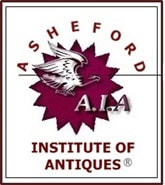 NOTE: For readers seeking more information about the Asheford Institute Of Antiques distance-learning program on professional-level appraising, the study of antiques, collectibles, vintage and mid-century modern items, please click here to visit the school's Home Page. Should you have additional questions about the Asheford program, you can also write to the school at: [email protected] or call the Registrar's Office toll-free at: 1-877-444-4508. |
AIA StaffWe're providing our students and reader's with the latest breaking news on events and happenings that we think might be of interest to both collectors and dealers alike. Including changes within the world of antiques, vintage, collectibles and appraising that might just have an effect on your bottom line. We're also interested in hearing from you - so if you've got a great newsworthy story, let us know, and you just might find it here! Archives
July 2024
CategoriesLegal Disclaimer: Extraneous opinions, statements and comments made by individuals represented within these posts do not necessarily reflect those of the Institute. The publication naming of specific business entities, organizations, and concerns, contained herein, in no way represents an endorsement or recommendation of services or products by the Institute. Publicly identifiable information contained herein (including, but not limited to contact information), has been intentionally limited where possible, due to privacy and legal concerns related to the digital dissemination of information through online means. All views expressed herein are those of their respective owners. The Institute is in no way responsible, financially or otherwise, for the accuracy or validity of statements contained within published posts from sources that originate and appear outside of the written and expressed views of those submitted by the Institute.
|
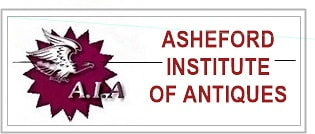
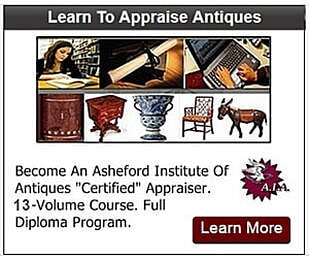
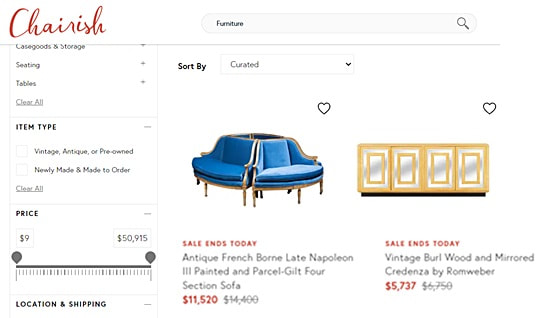
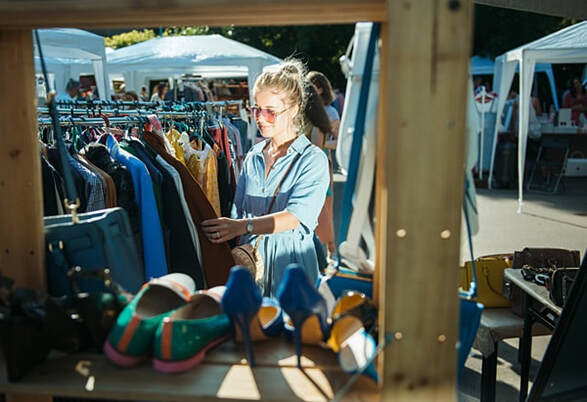
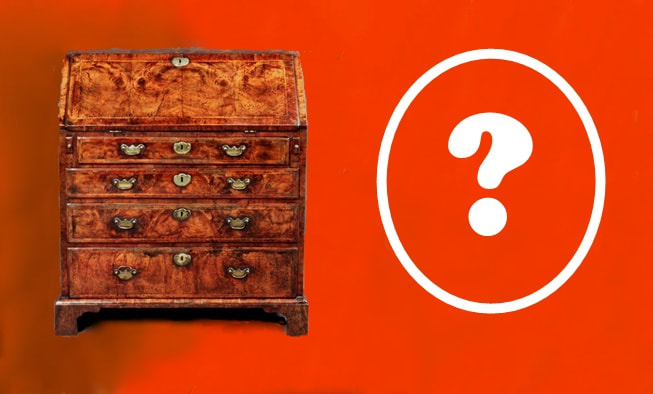
 RSS Feed
RSS Feed



